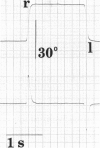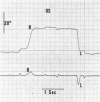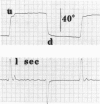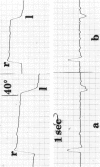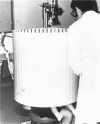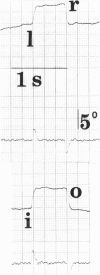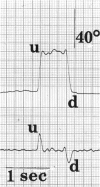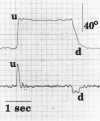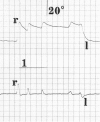Abstract
Traditional evaluation of strabismus has included cover test measurements, evaluation of the range of ocular rotations, and an array of subjective sensory tests. These studies could not always differentiate paresis of an extraocular muscle from restrictions and from various neuro-ophthalmic motility disorders. The measurement of horizontal and vertical saccadic movements can provide an objective test of rectus muscle function. Using EOG, saccades can be recorded easily, inexpensively, and repeatably at any age. In ocular muscle paresis or paralysis, saccadic speed is reduced mildly to markedly and can be used to monitor recovery. Assessment of saccadic velocity does not appear useful in evaluating superior oblique palsy, although it is valuable in sixth nerve palsy, Duane's syndrome, and third nerve palsy. When restrictions are the major cause of limited rotation, as in thyroid ophthalmopathy and orbital floor fracture, saccadic speed is unaffected. The induction of OKN or vestibular nystagmus is helpful in the study of children too young to perform voluntary saccadic movements. In patients with limitation of elevation or depression, this technique can separate innervational from mechanical causes of diminished rotation. The specific saccadic velocity pattern in myasthenia gravis, progressive external ophthalmoplegia, internuclear ophthalmoplegia, and Möbius' syndrome is helpful in differentiating these disorders from other neuroophthalmic motility problems. Transposition surgery of the rectus muscle is effective because of an increase in force, seen as an improvement in saccadic velocity and resulting from the change of insertion of the muscles. Saccadic velocities can also be of assistance in diagnosing a lost or disinserted muscle following surgery for strabismus. Although analysis of saccadic velocity is not required for the proper evaluation of all problems in strabismus and motility, it can be of inestimable value in the diagnosis of many complex and confusing disorders. Together with forced duction testing, a clinical profile can be obtained concerning muscle force and muscle and orbital restrictions, which are required information for appropriate surgical planning.
Full text
PDF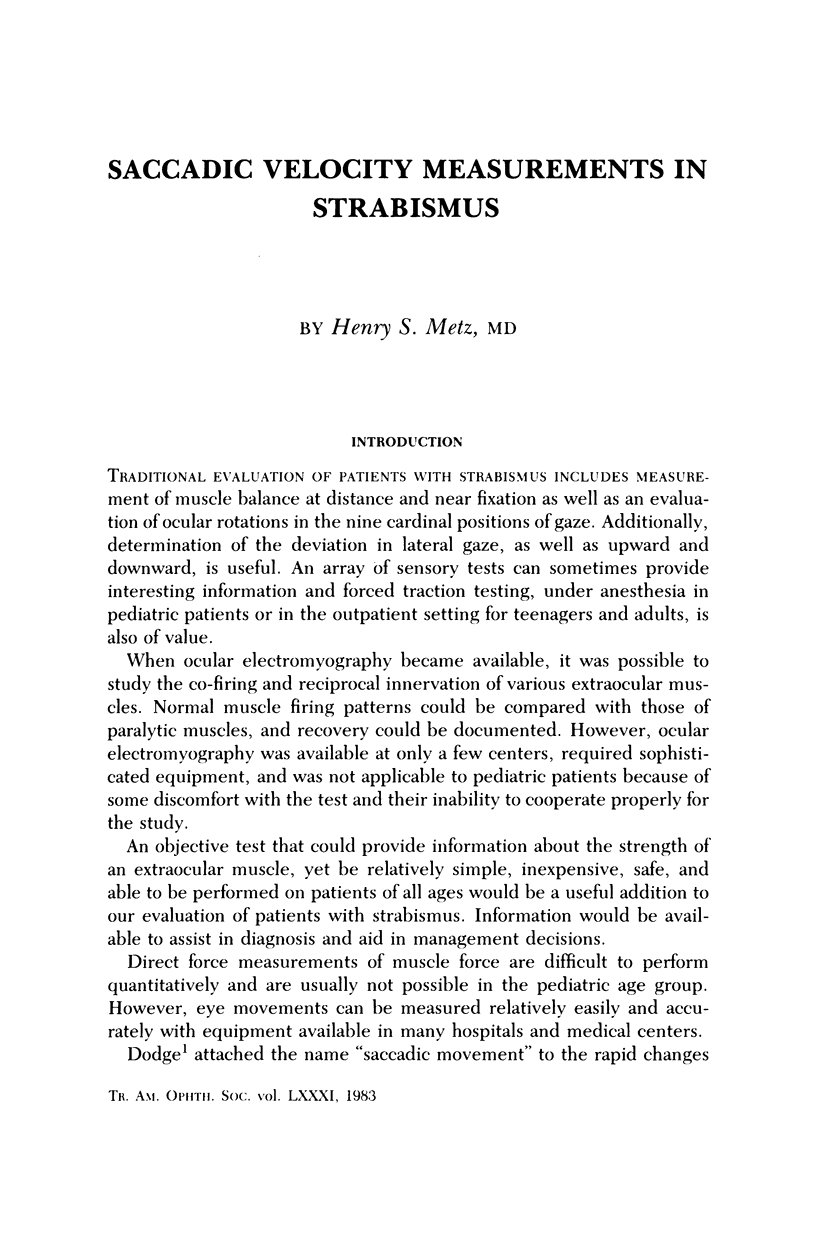
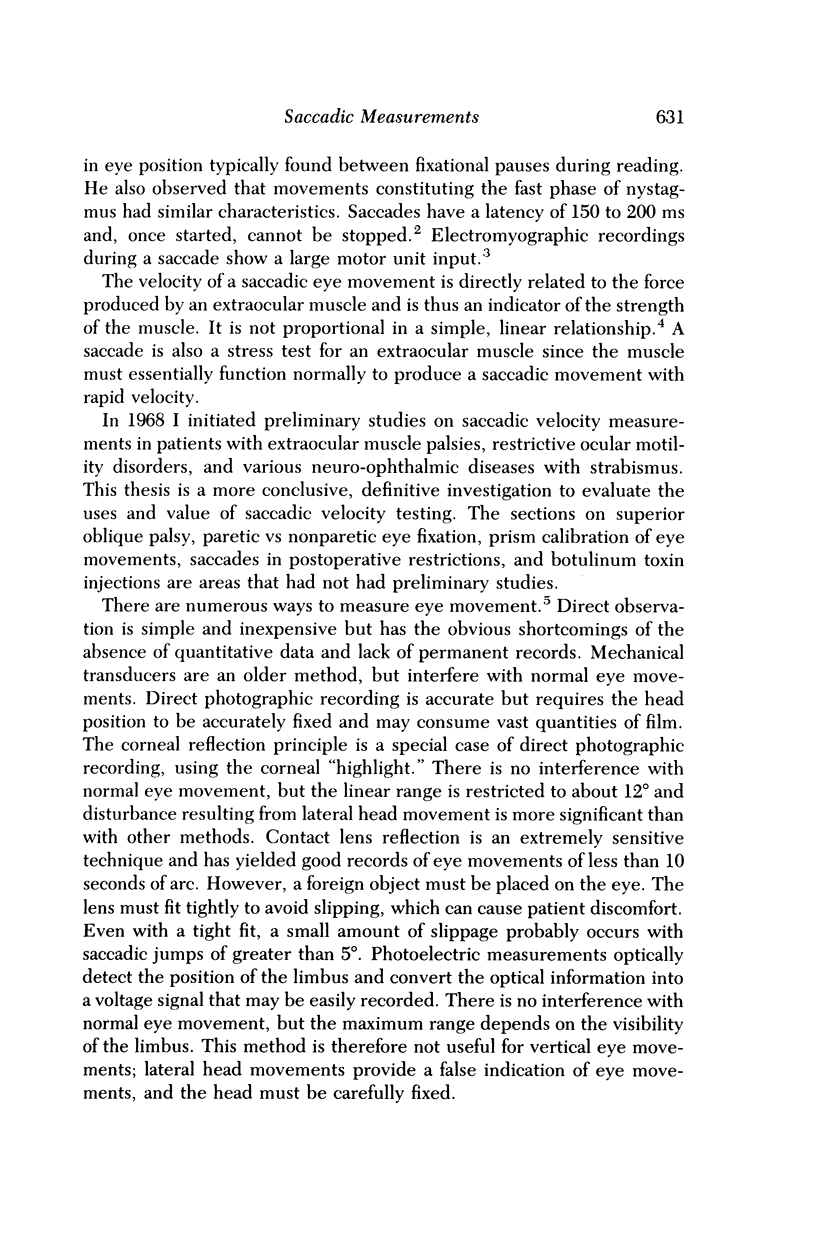
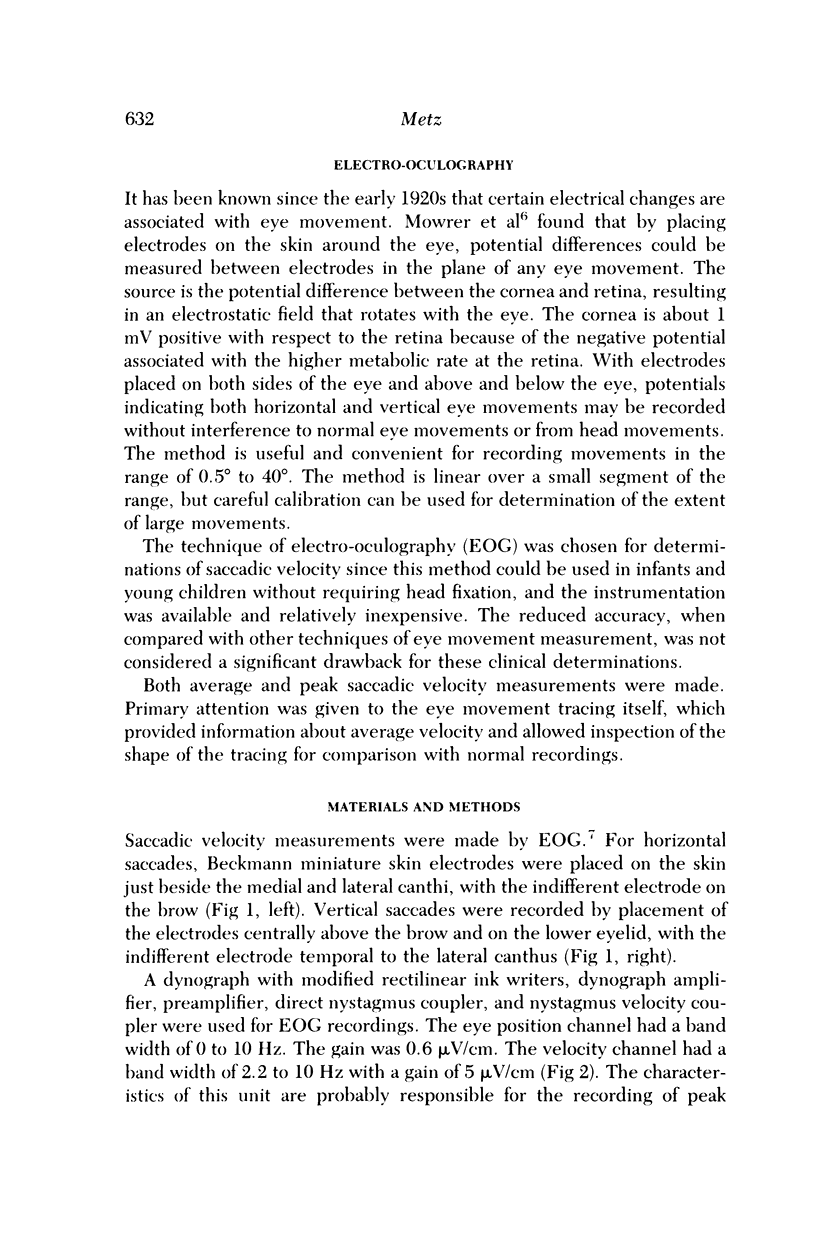
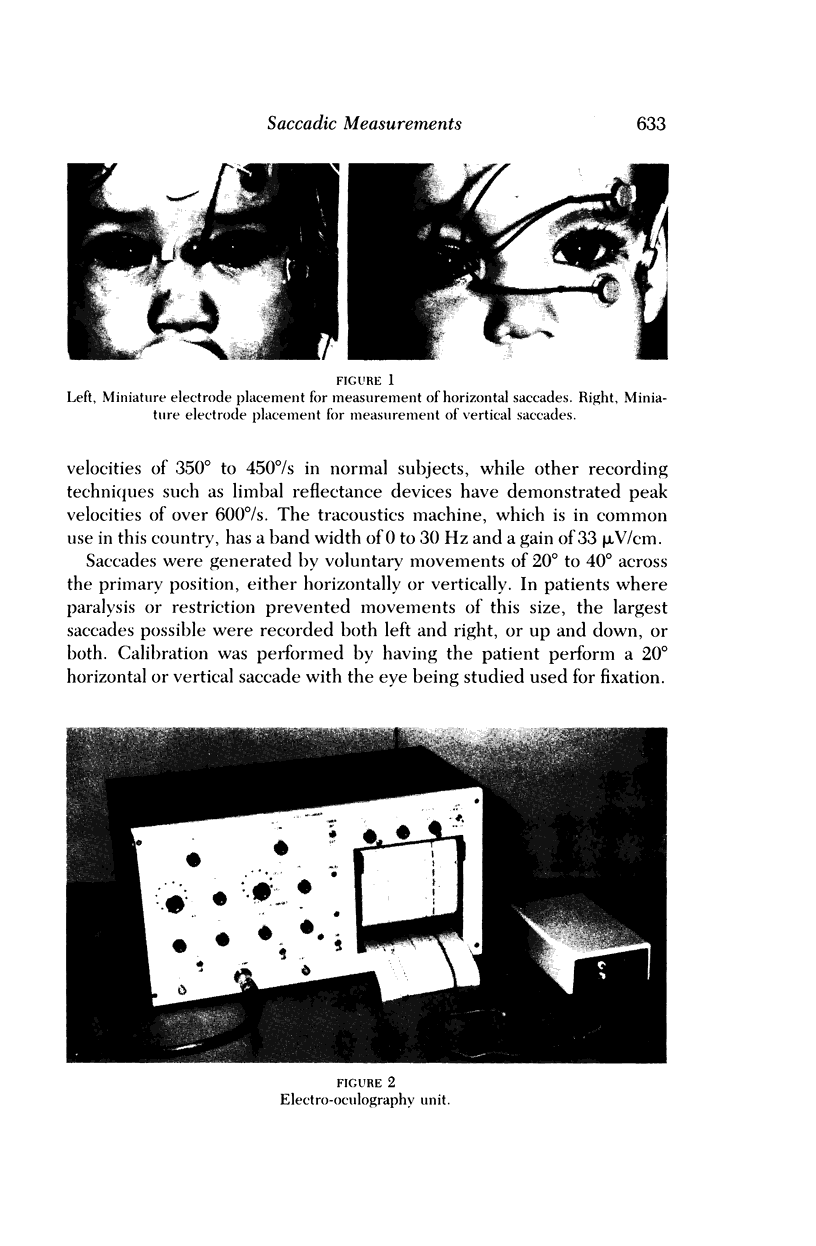
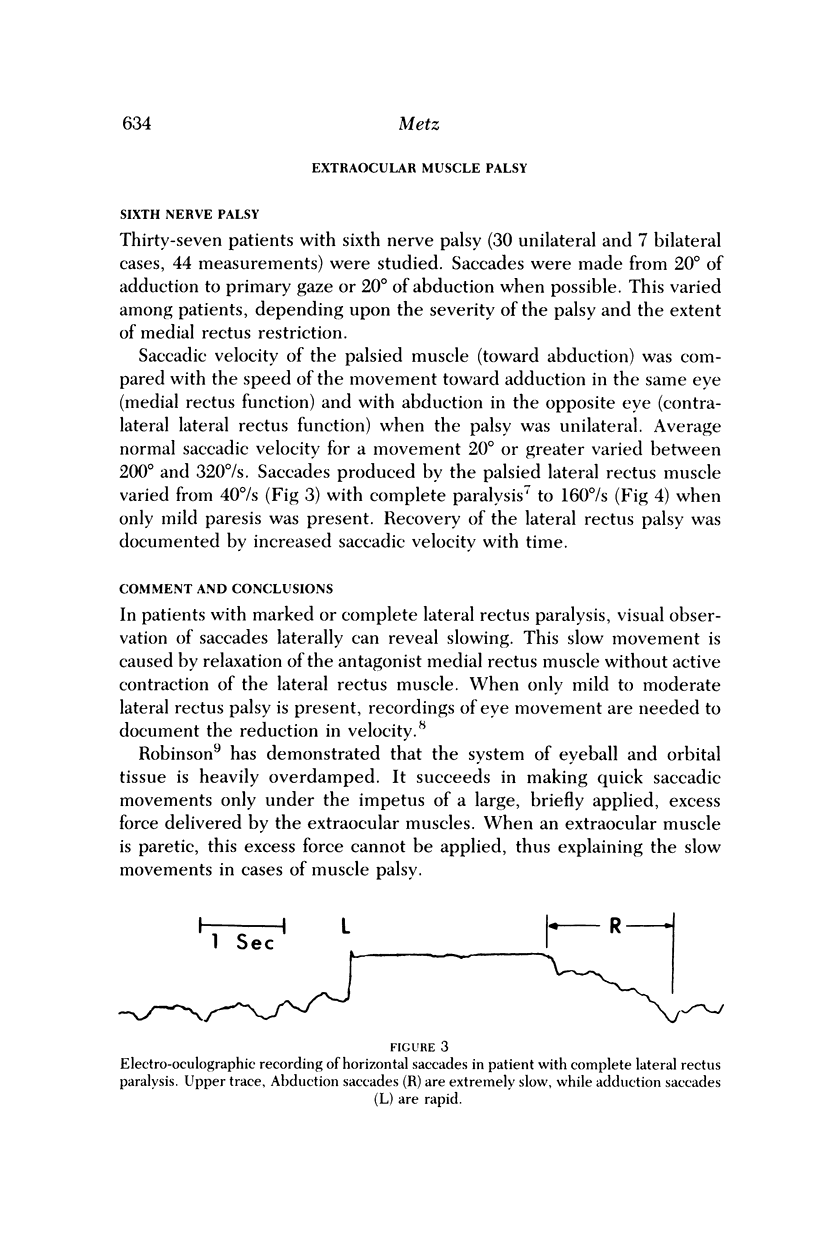
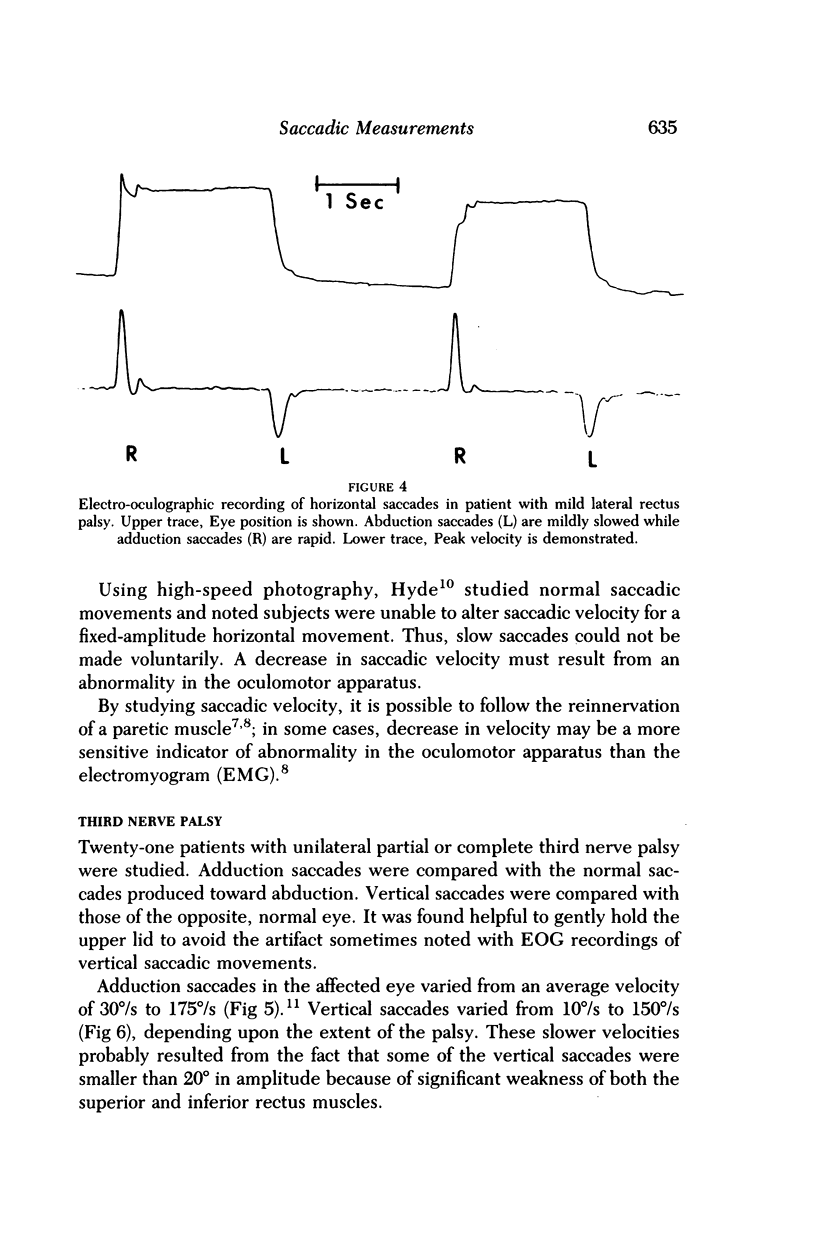
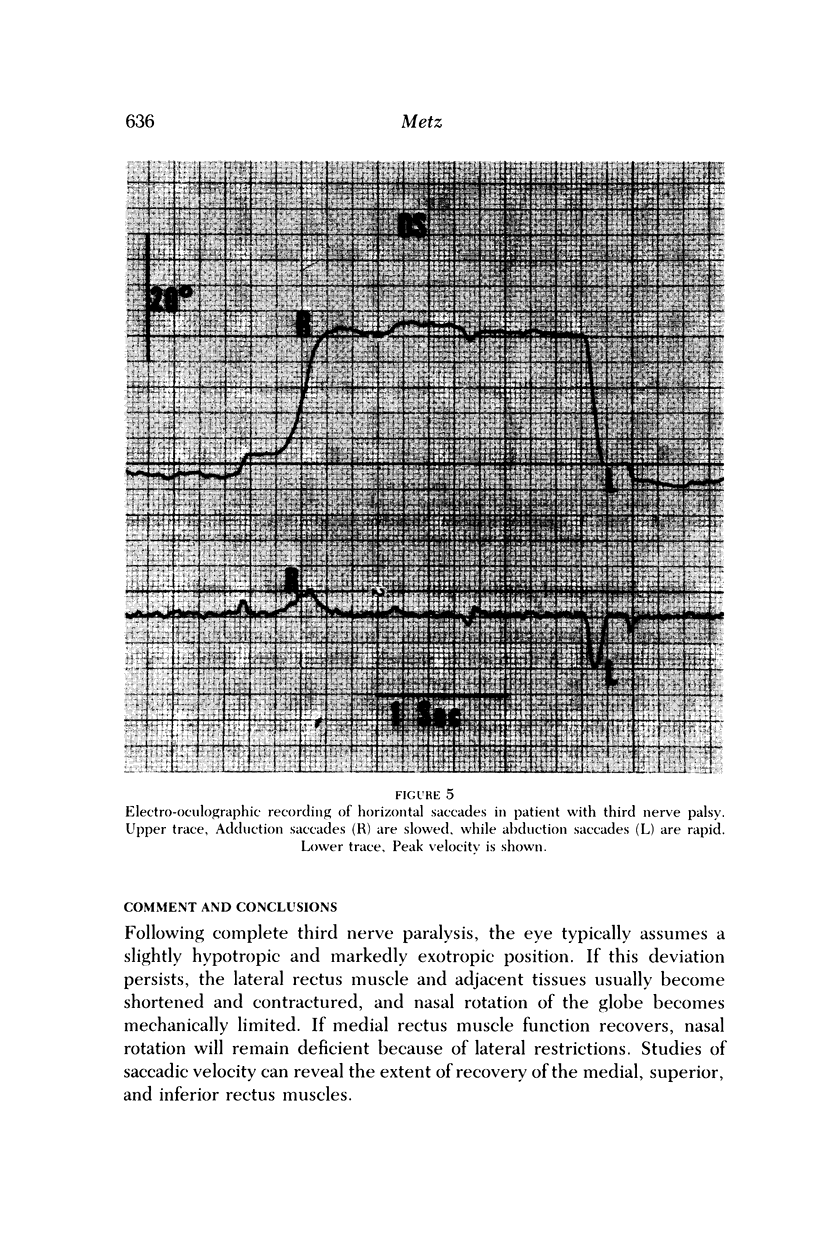
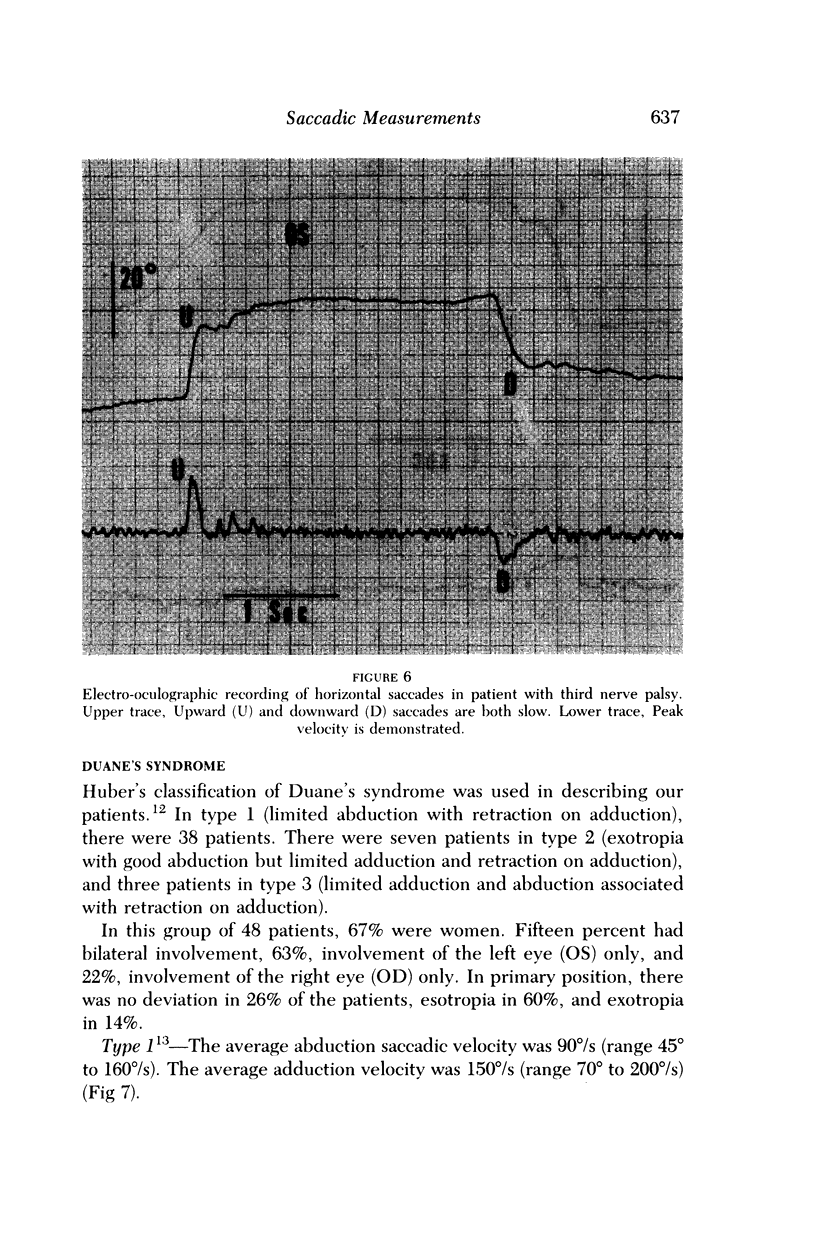

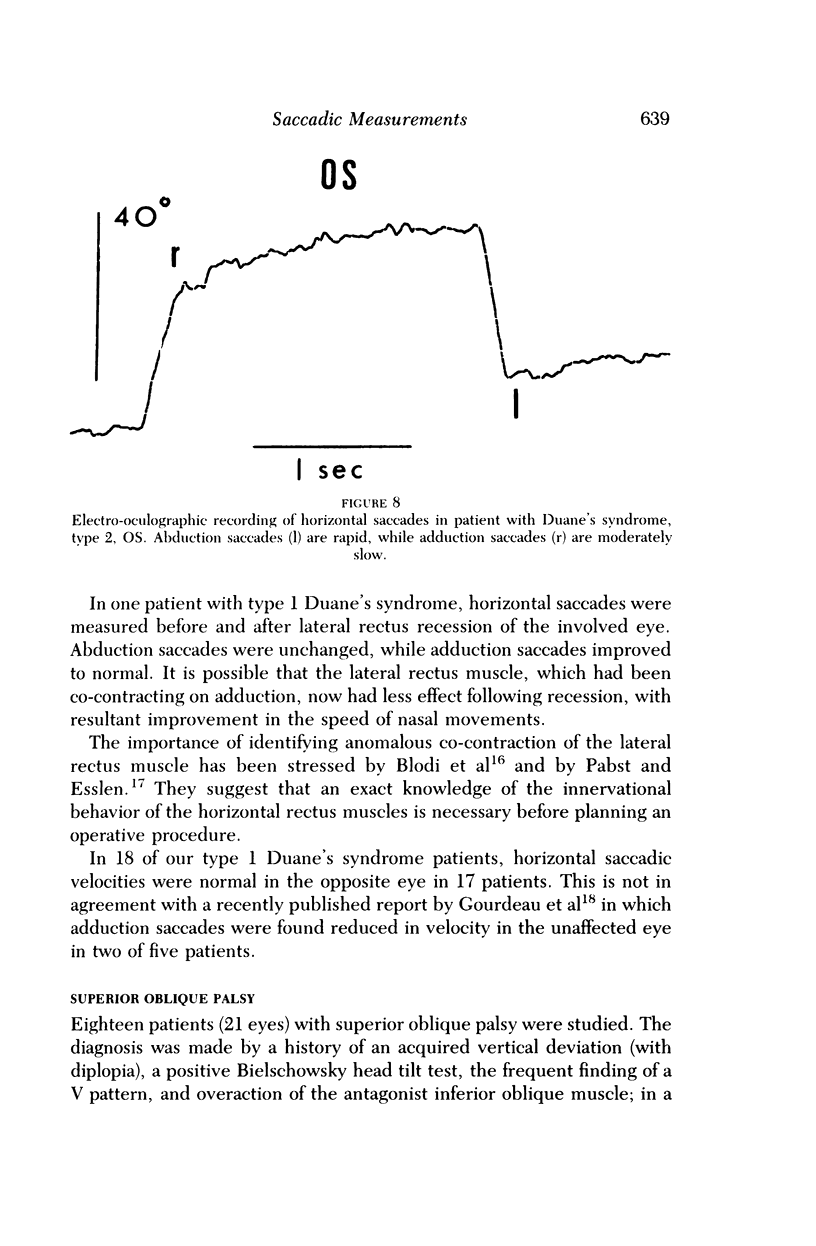
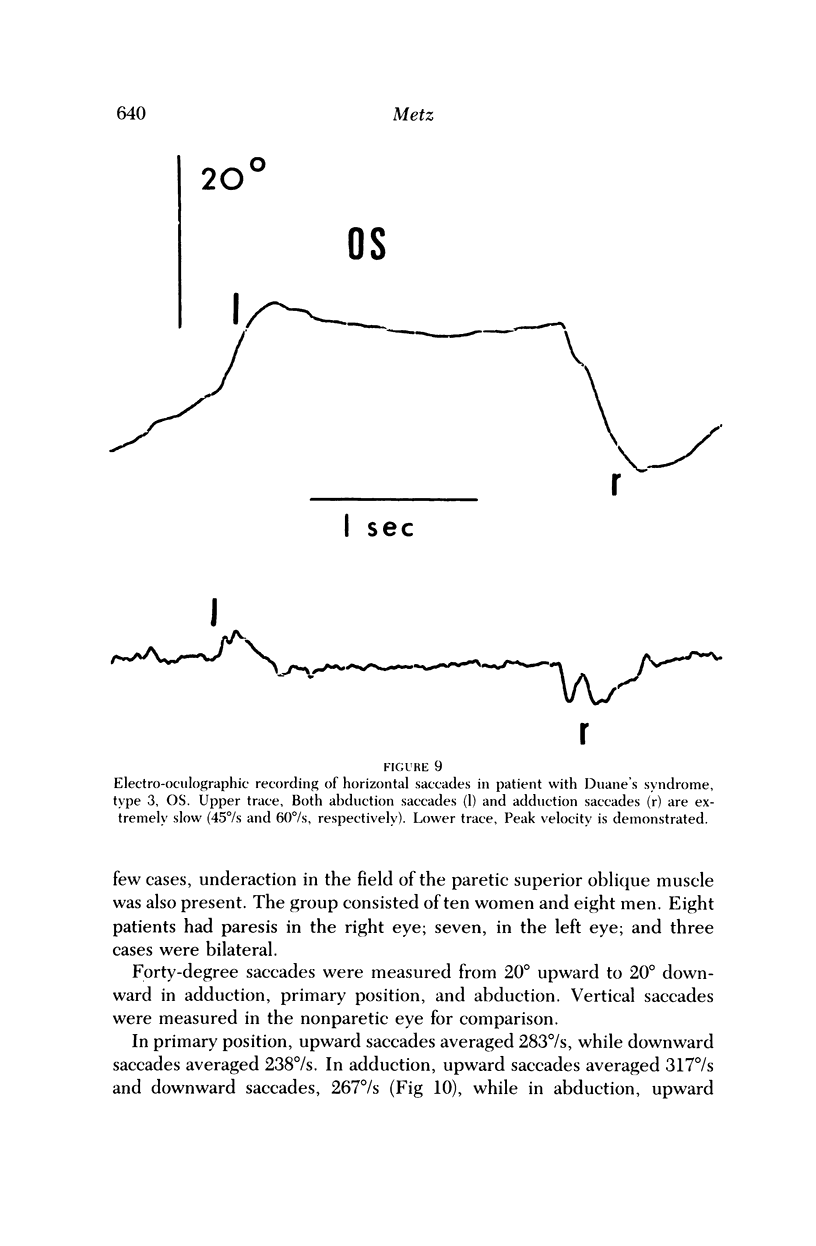
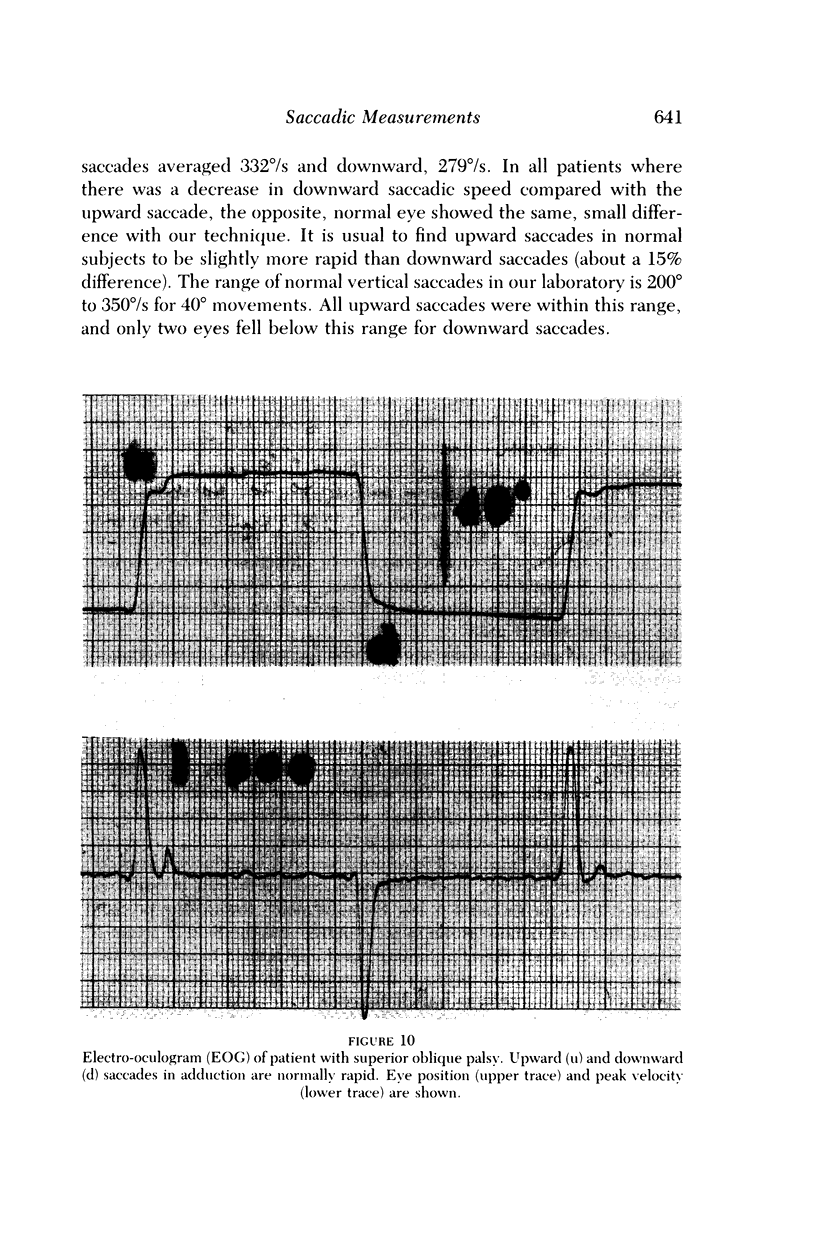
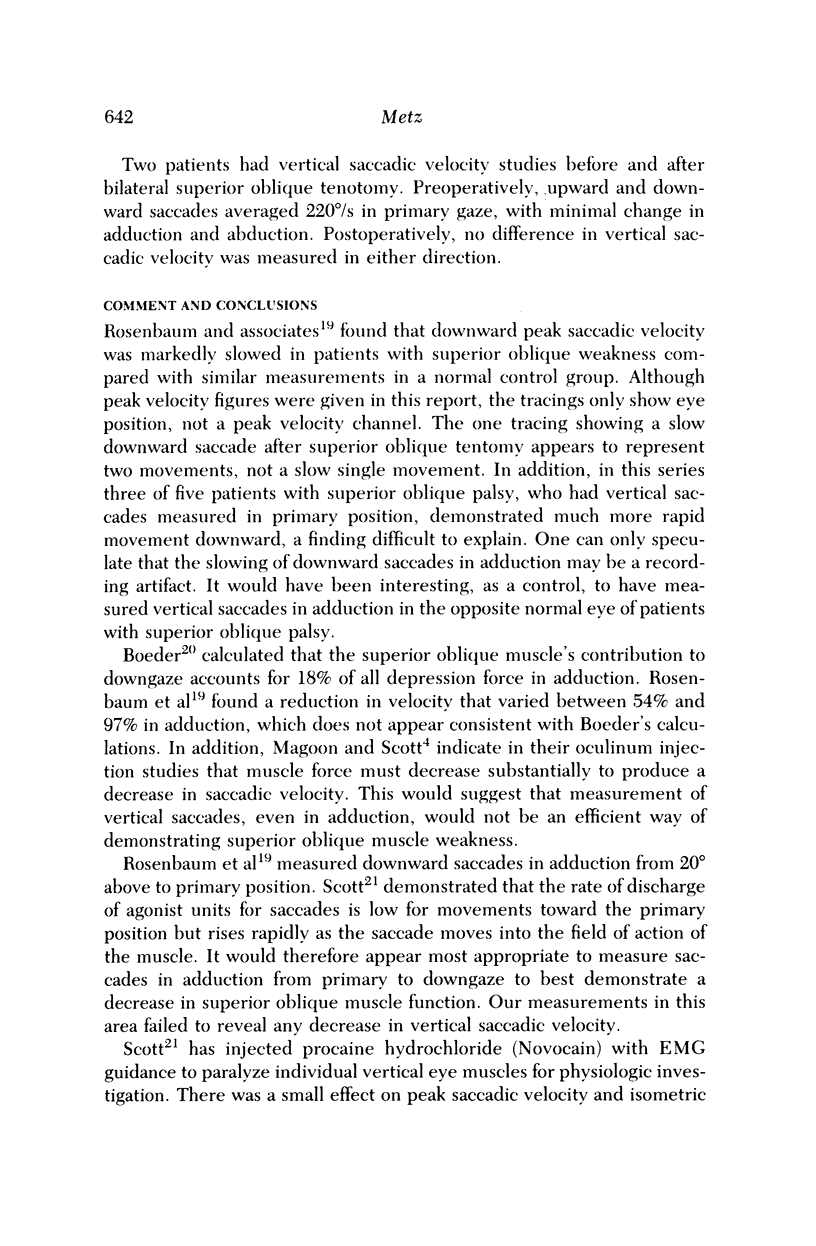
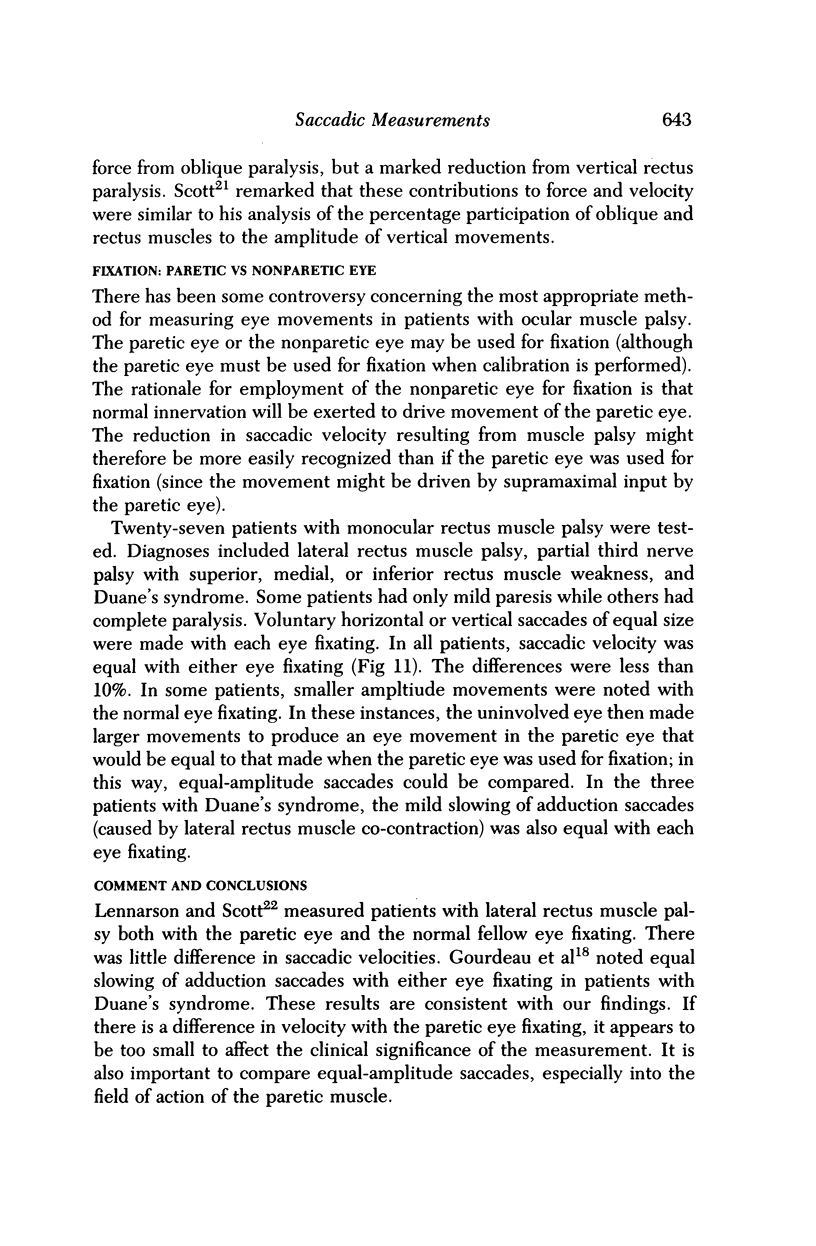
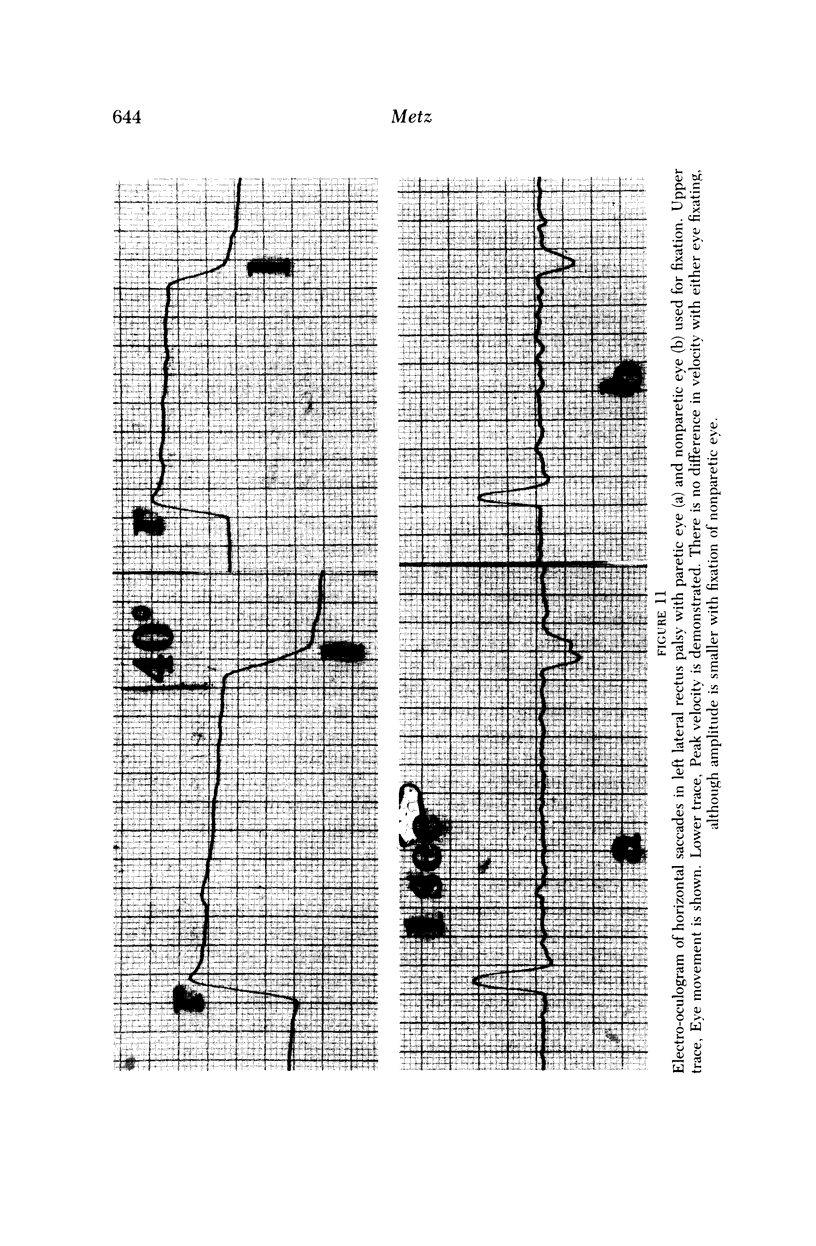
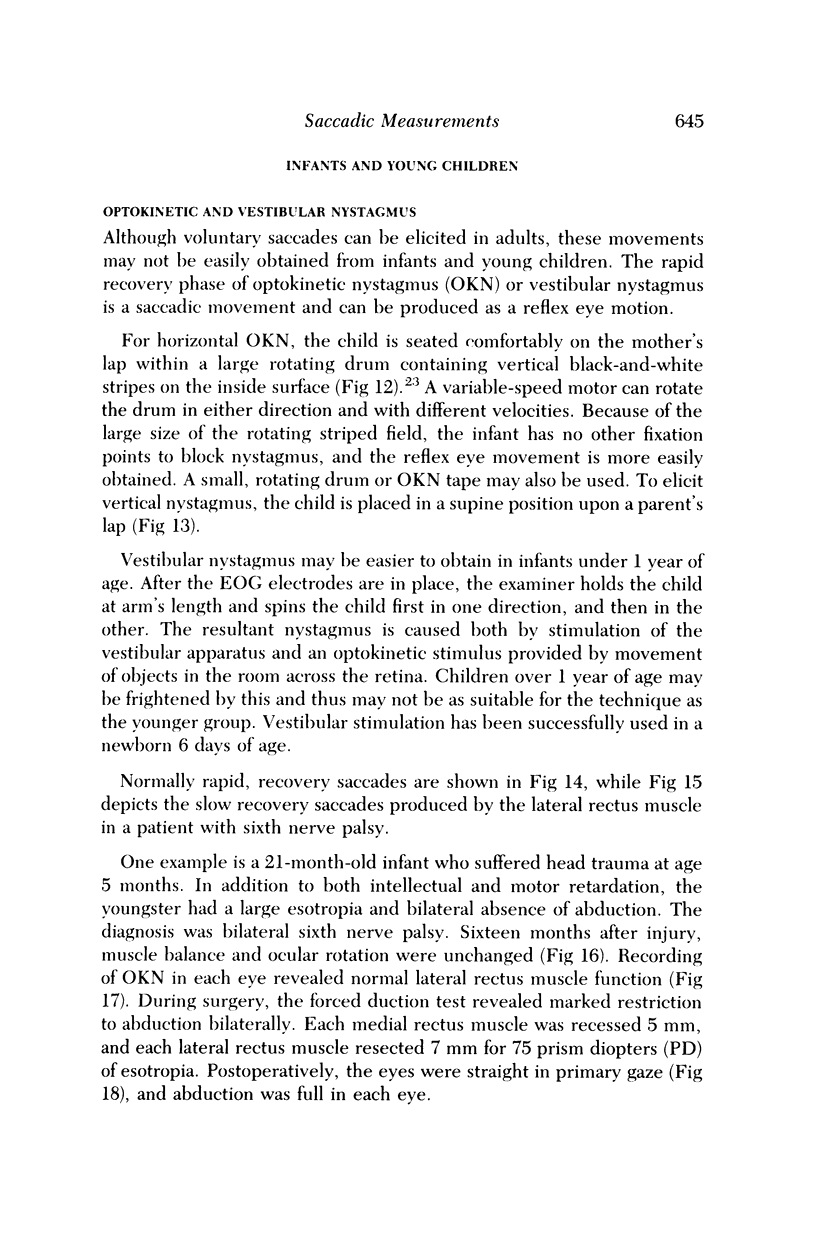
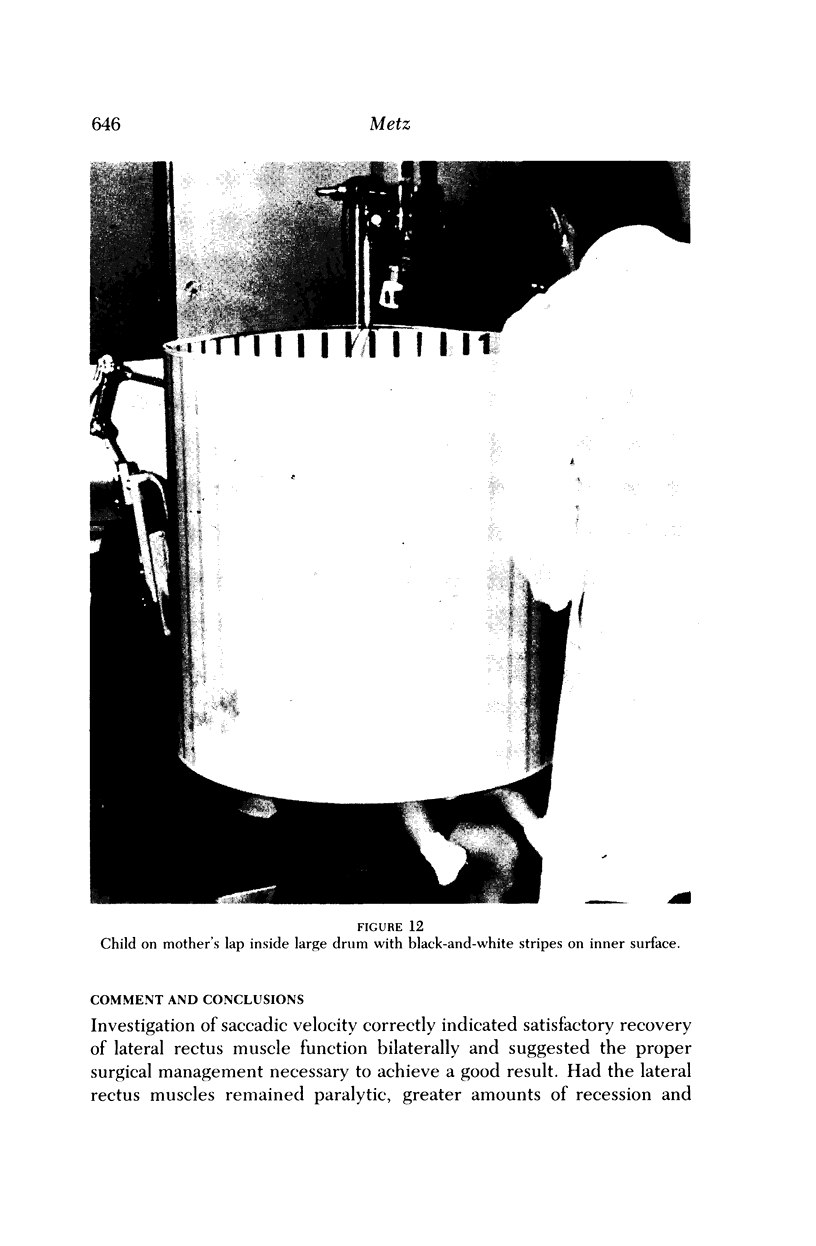
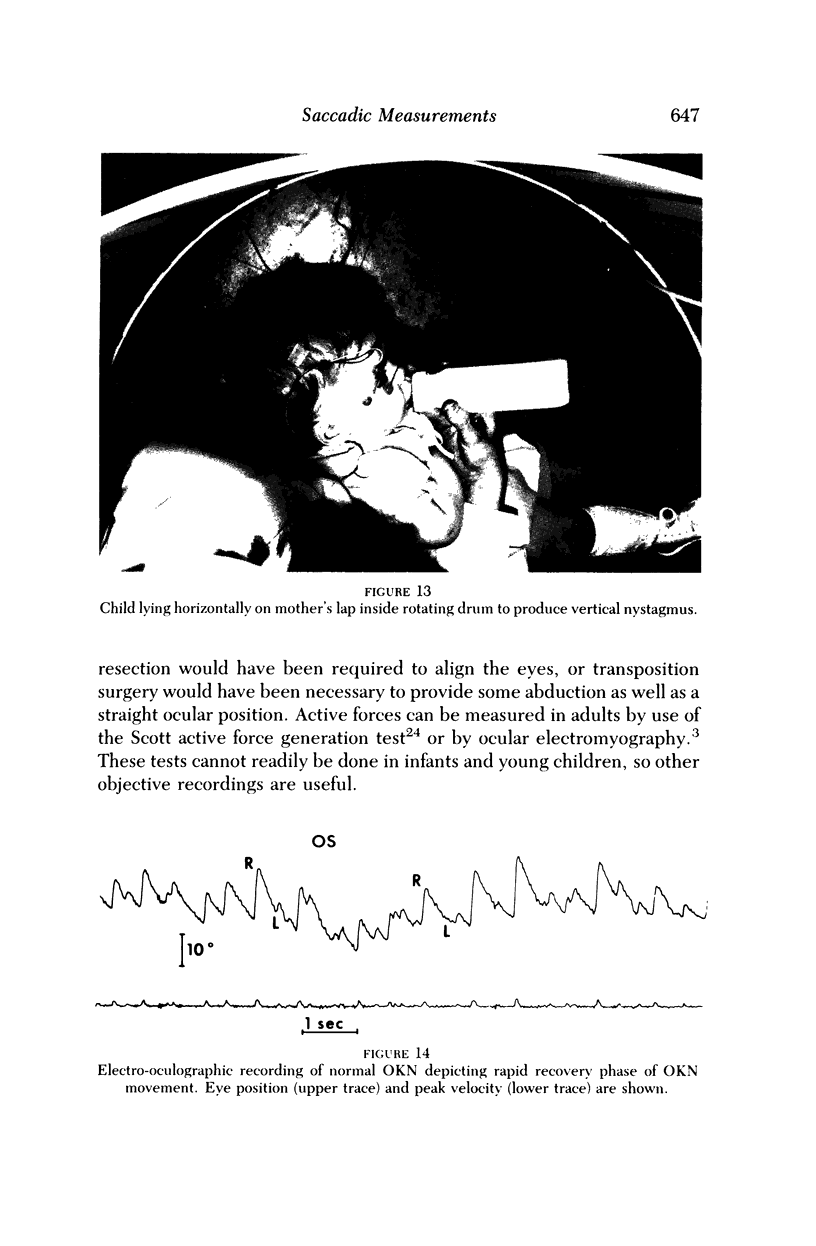
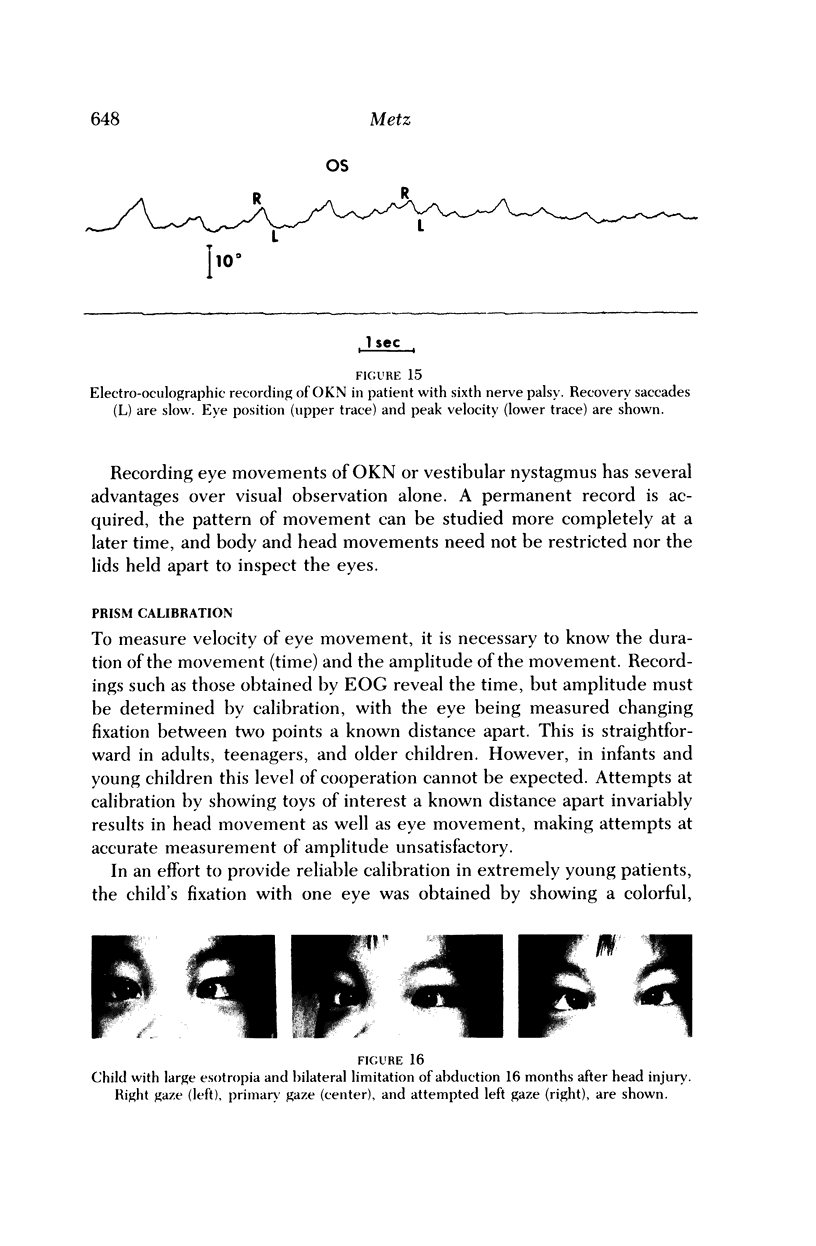
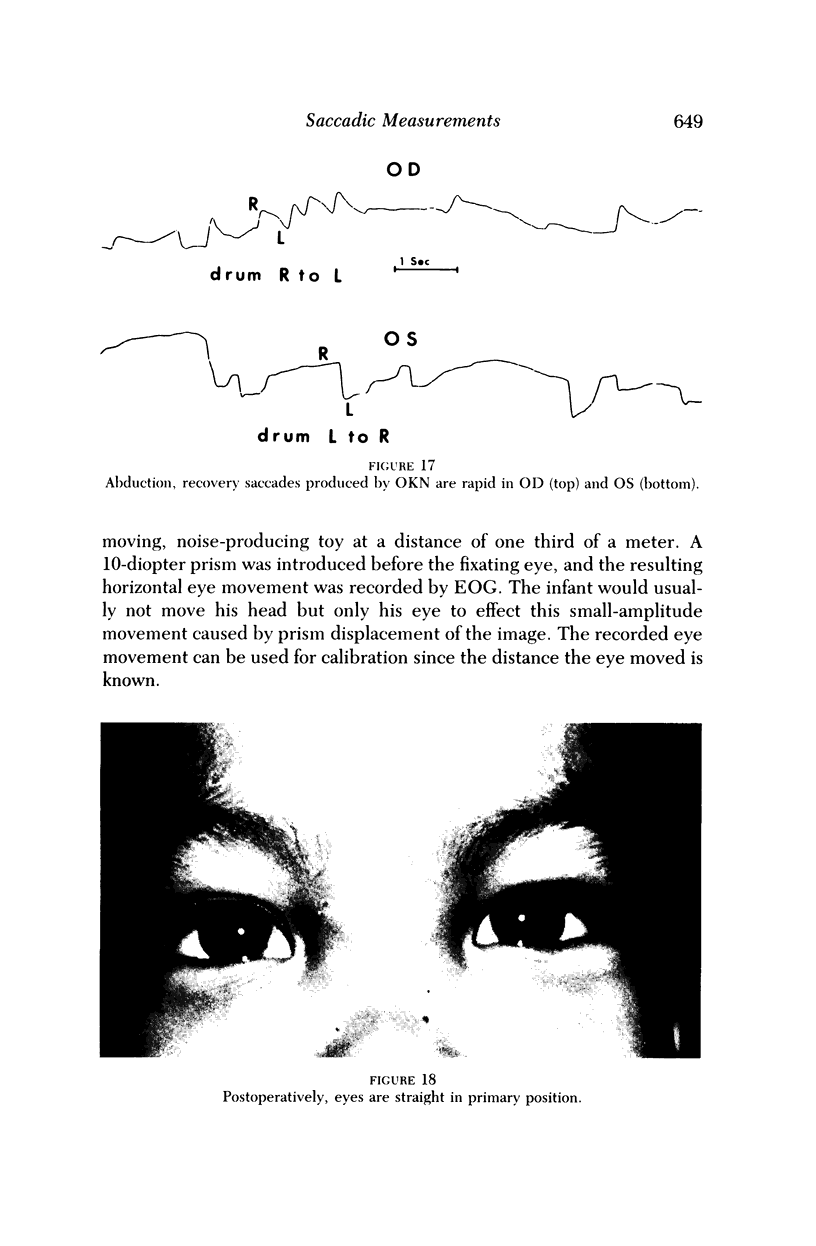

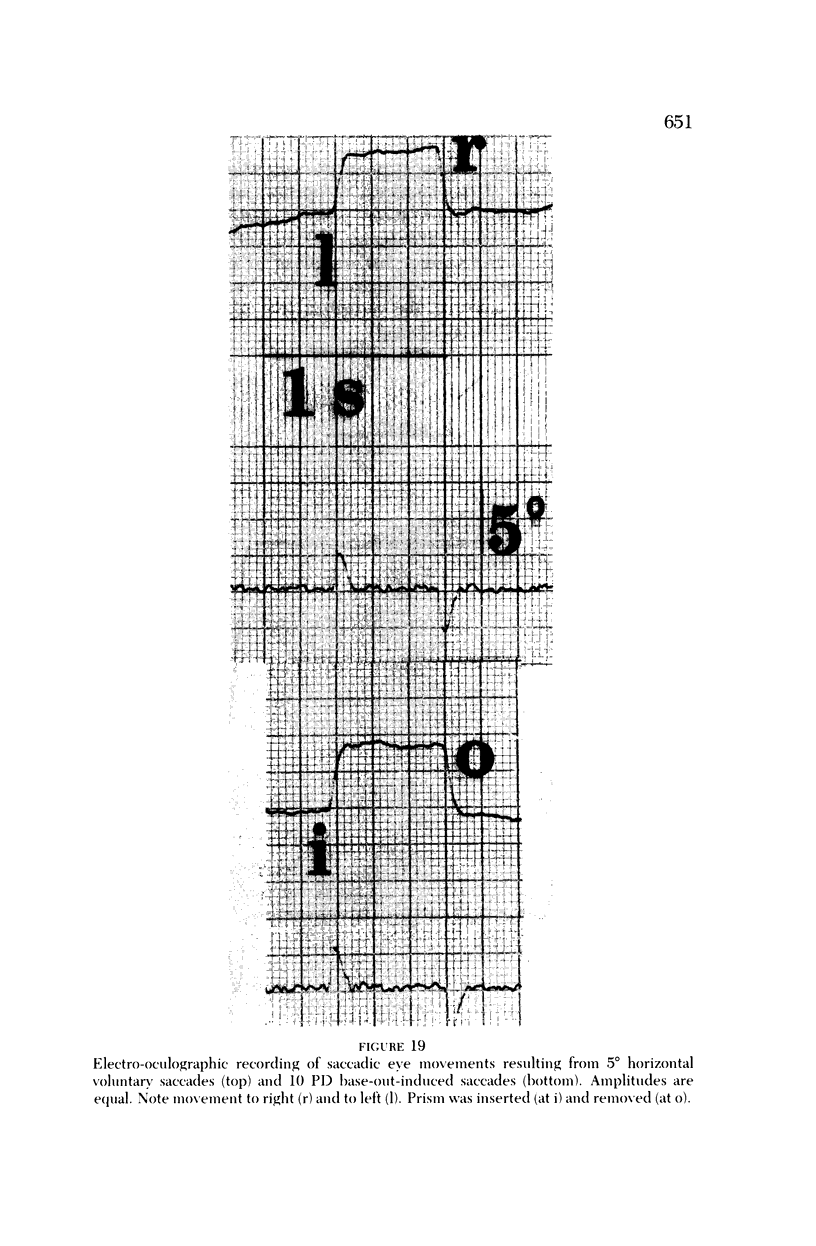
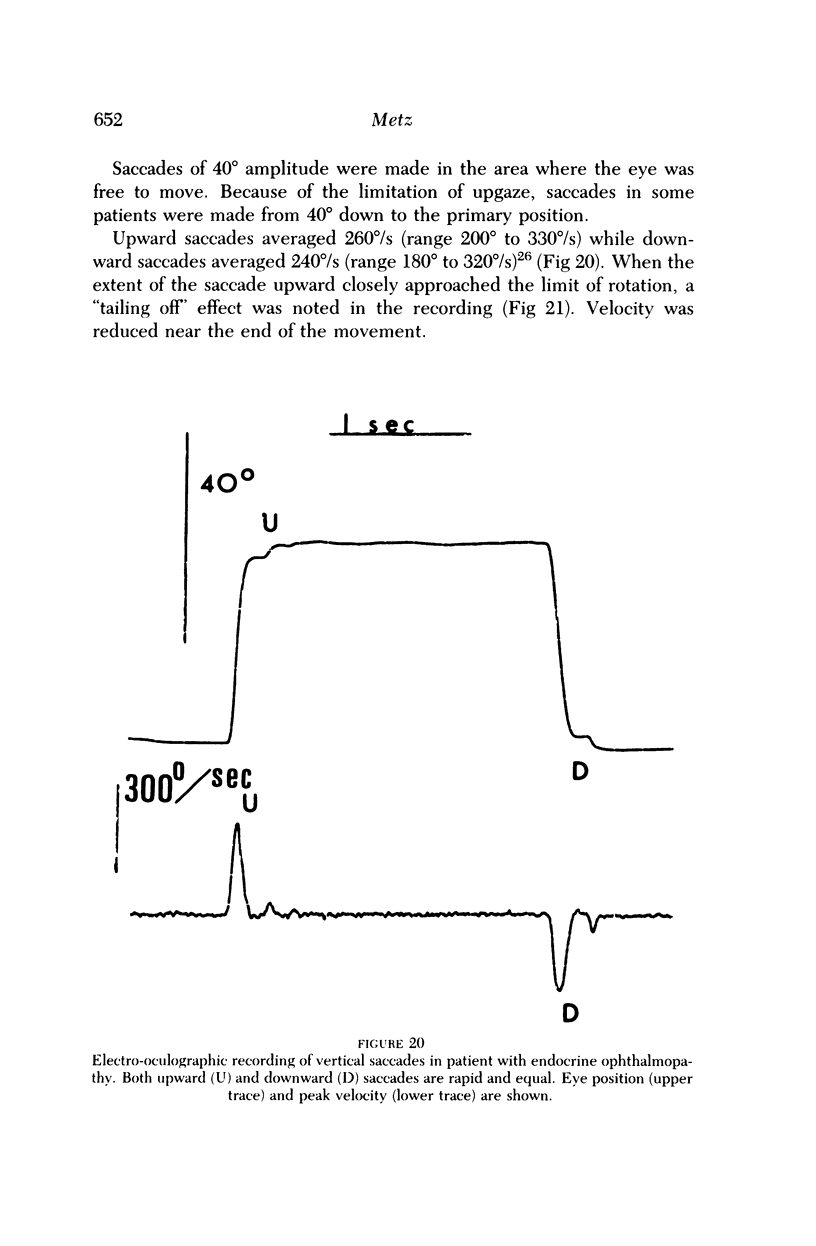

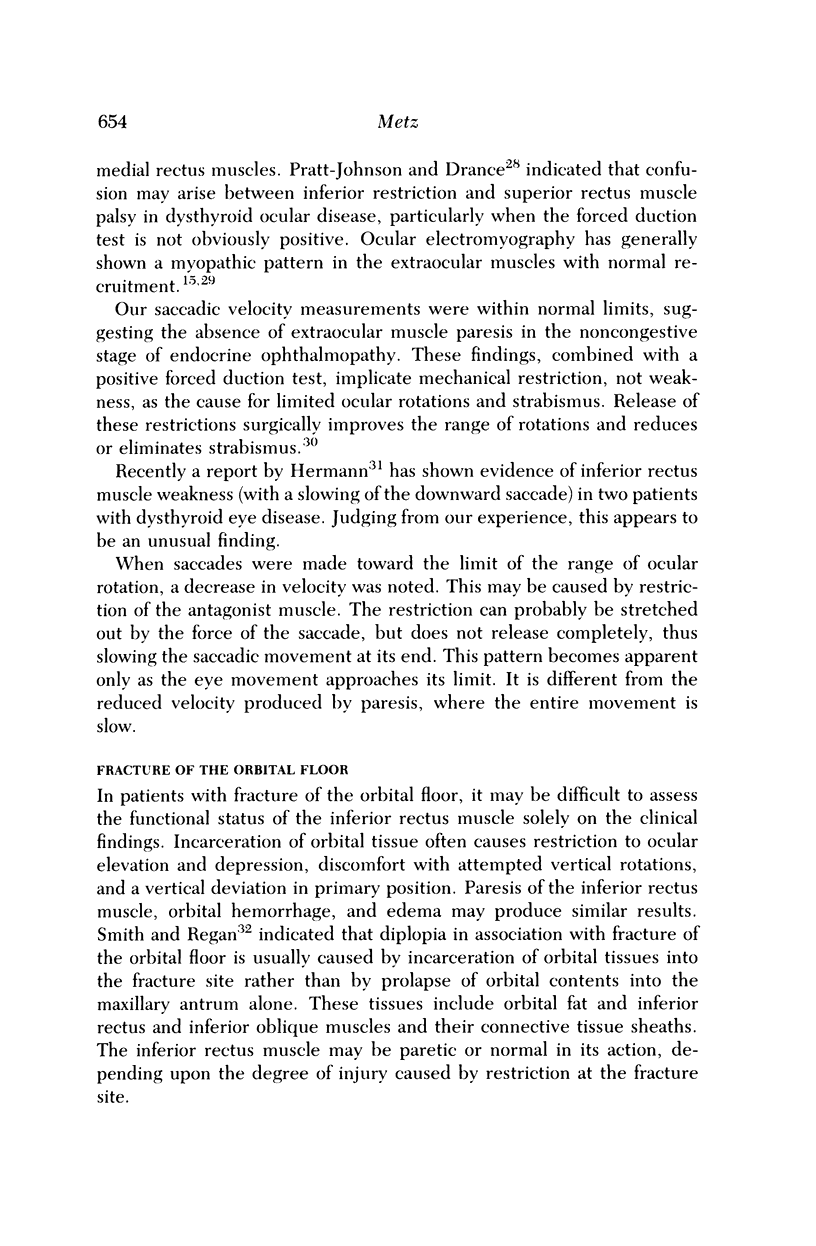
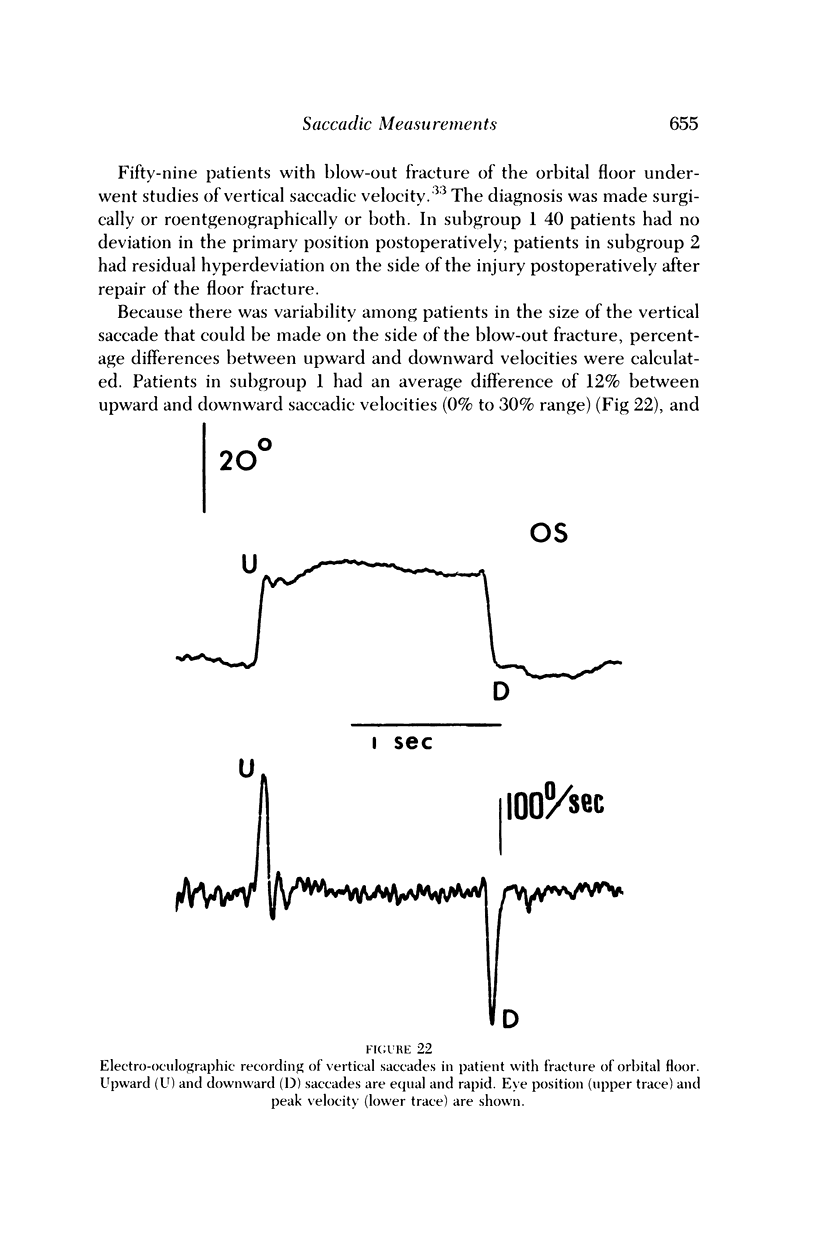

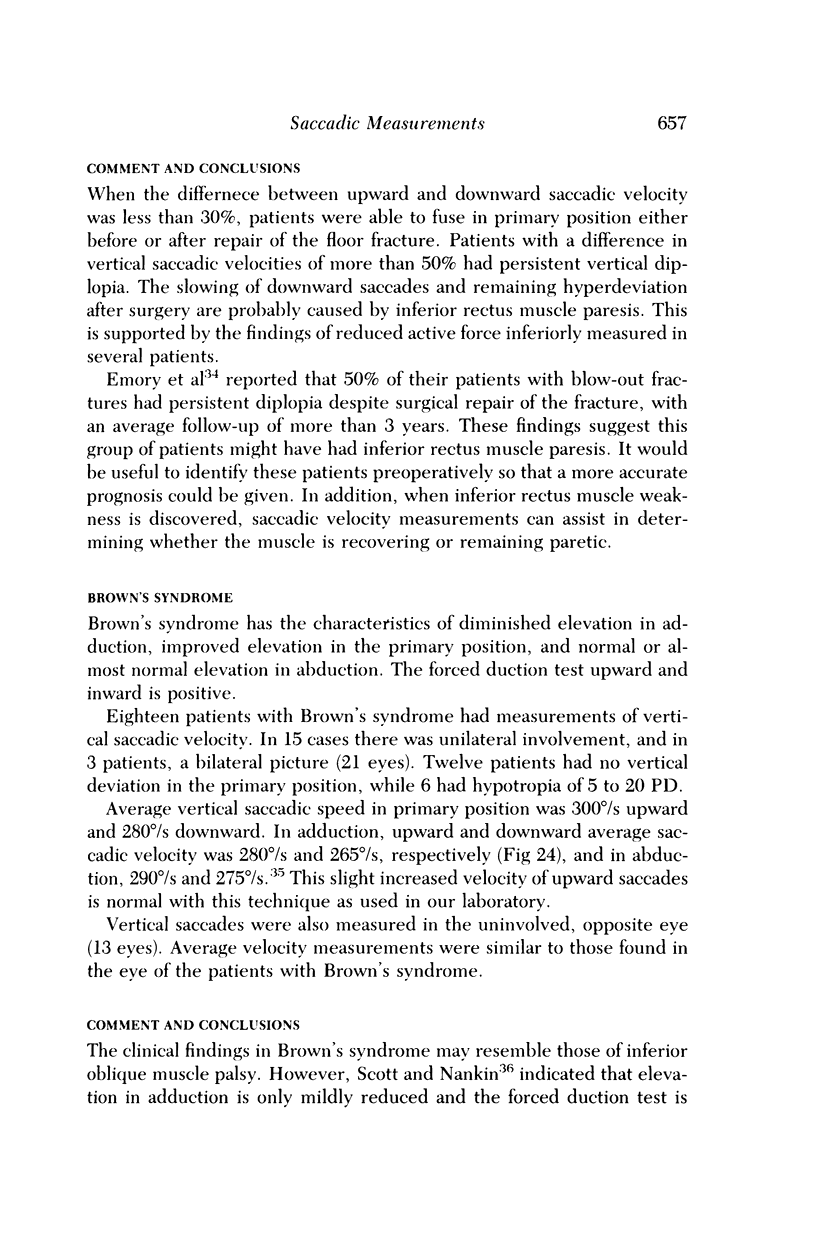
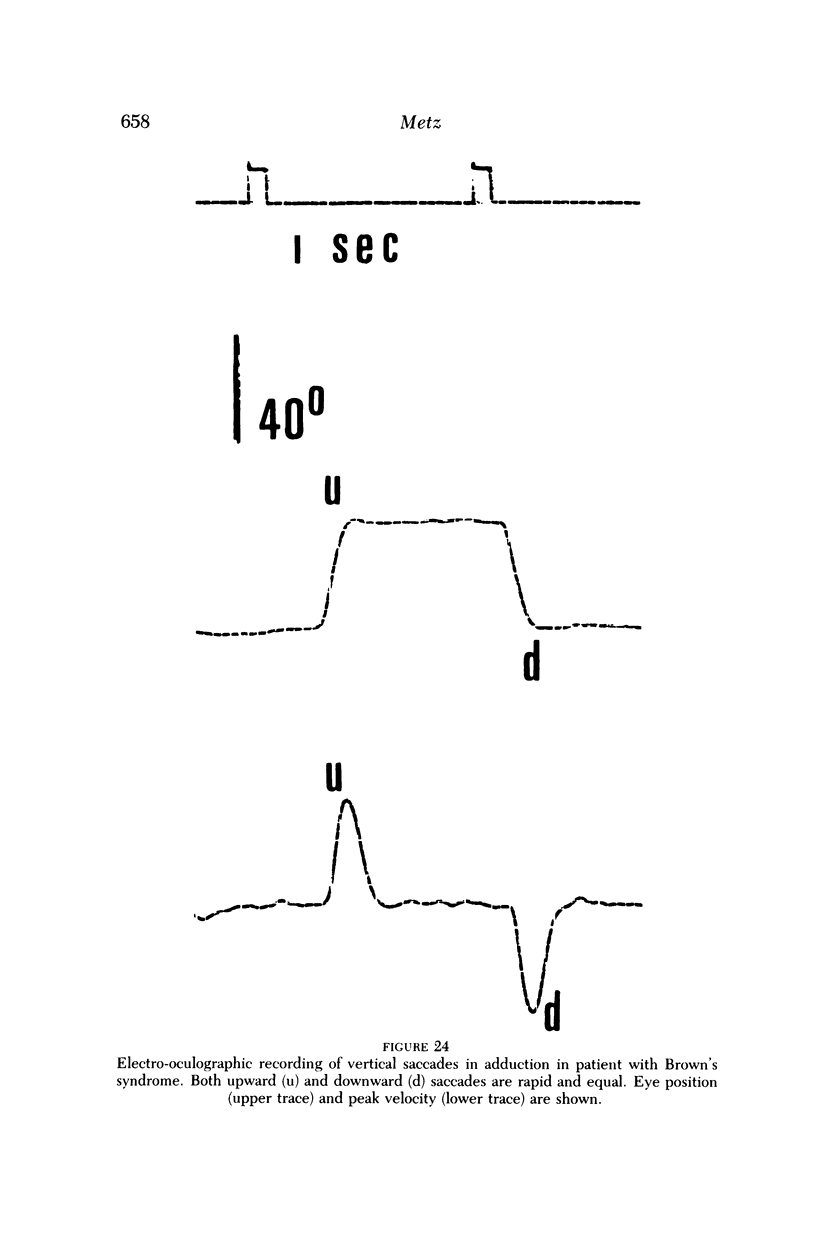
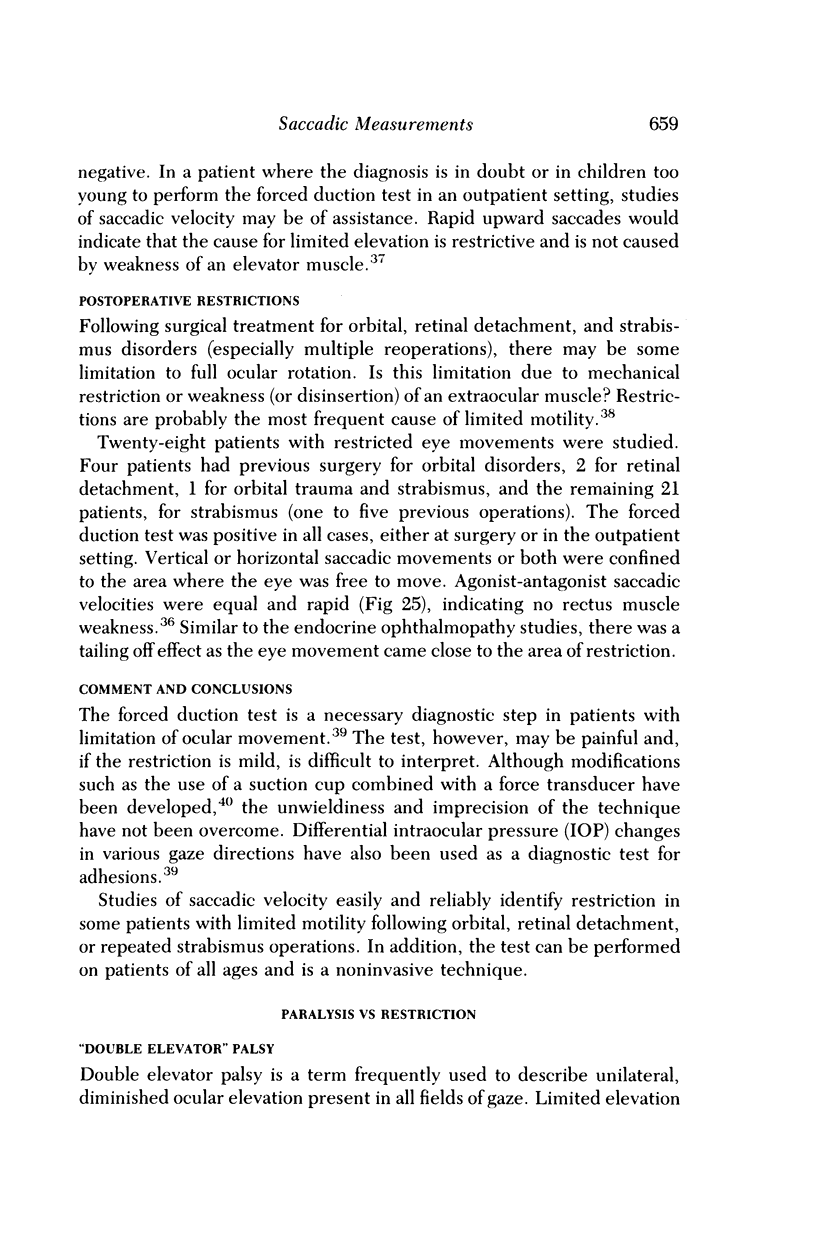
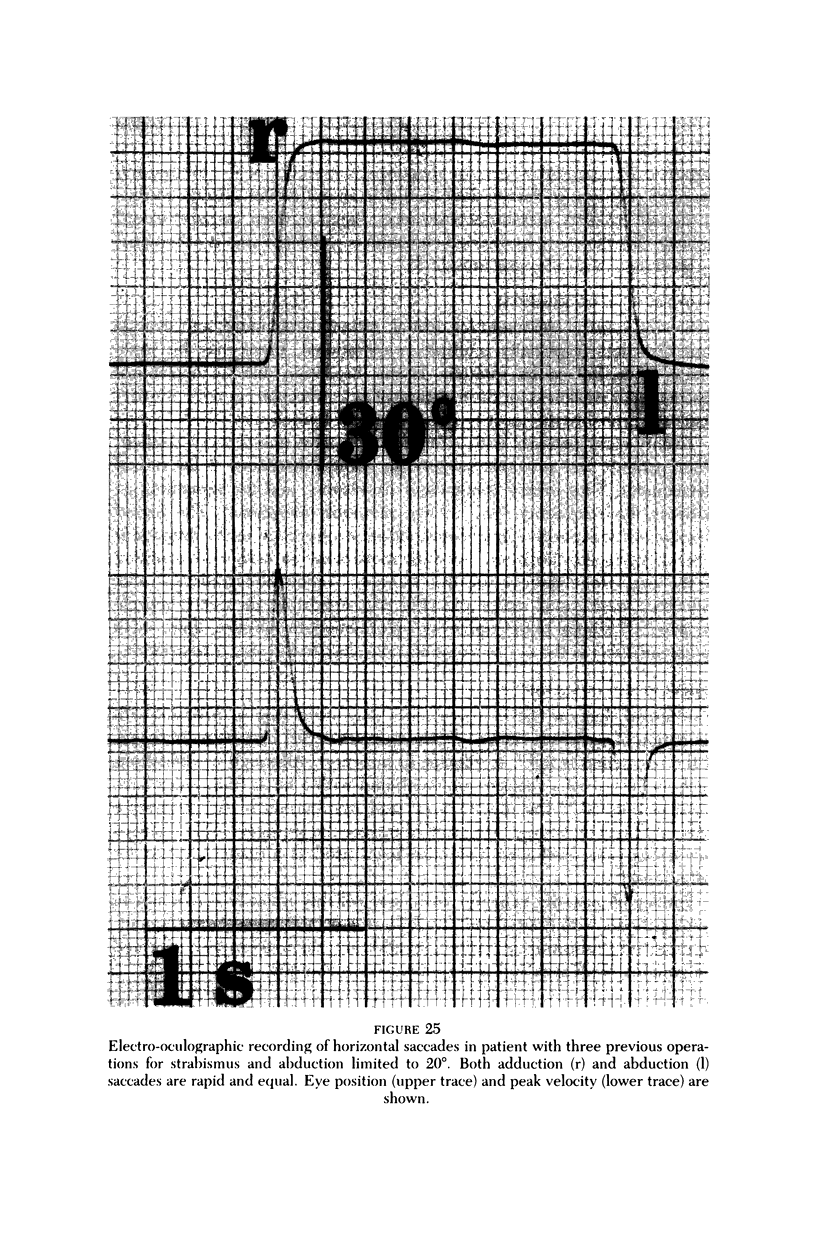
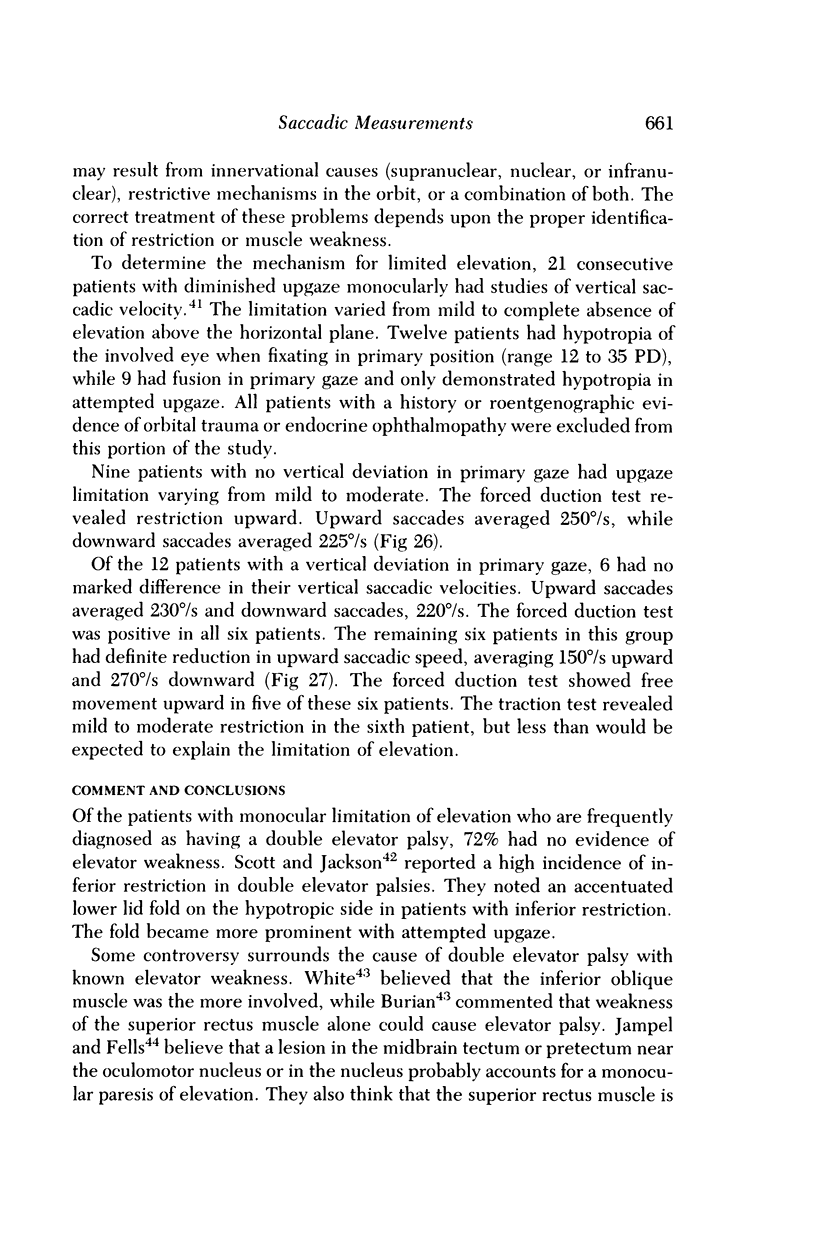
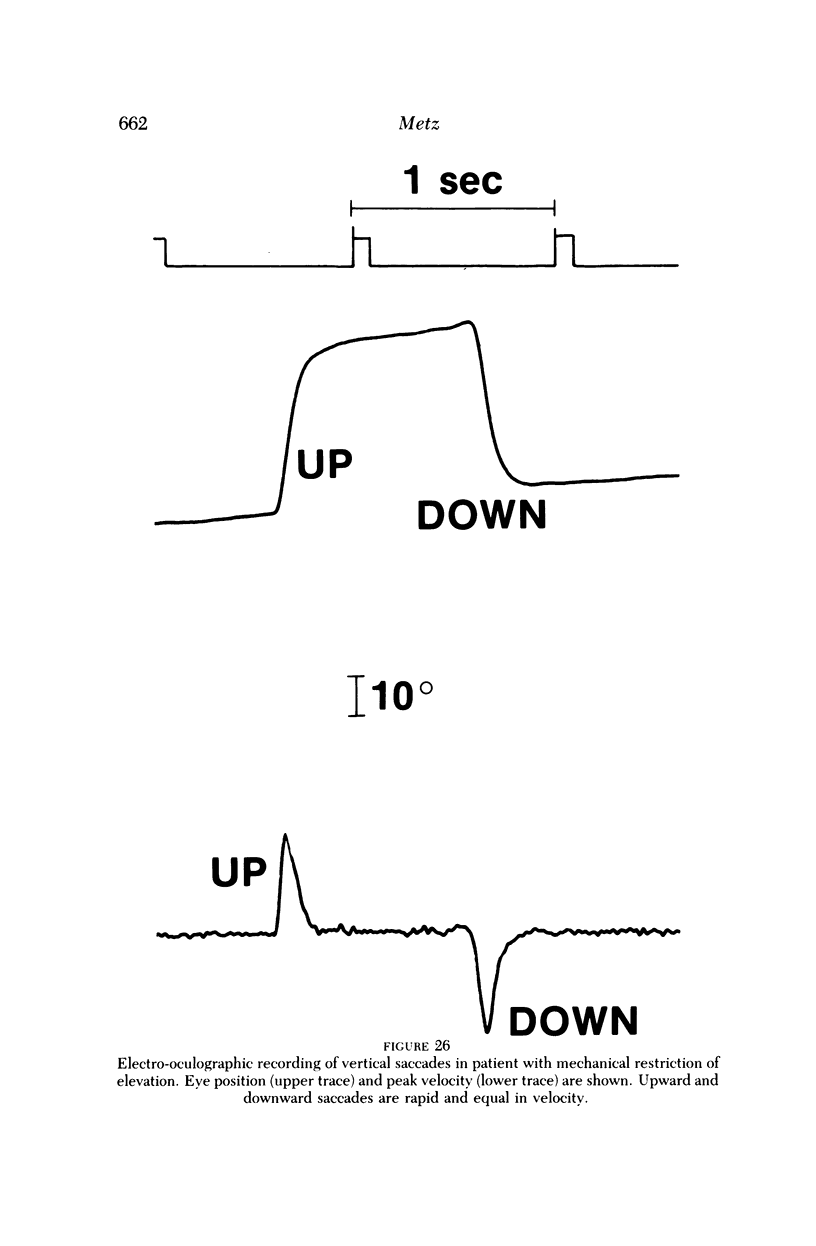
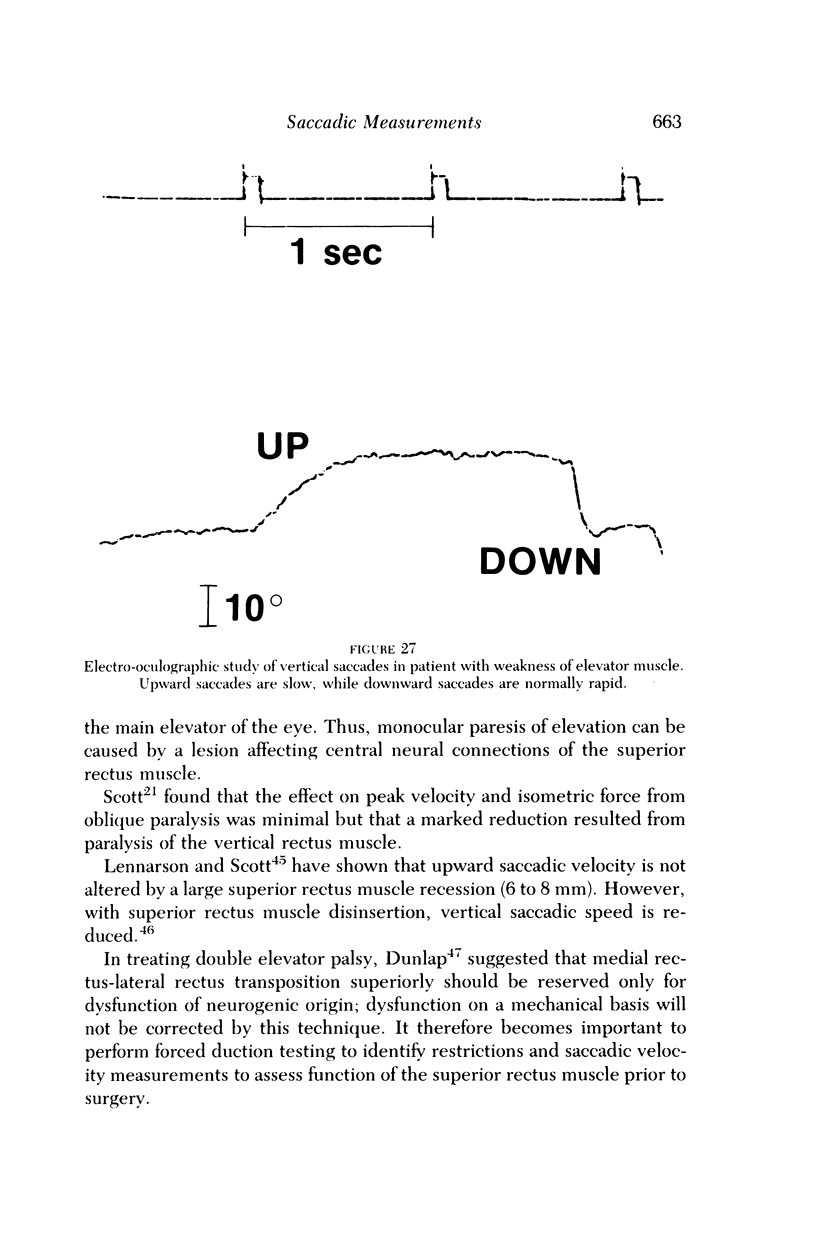
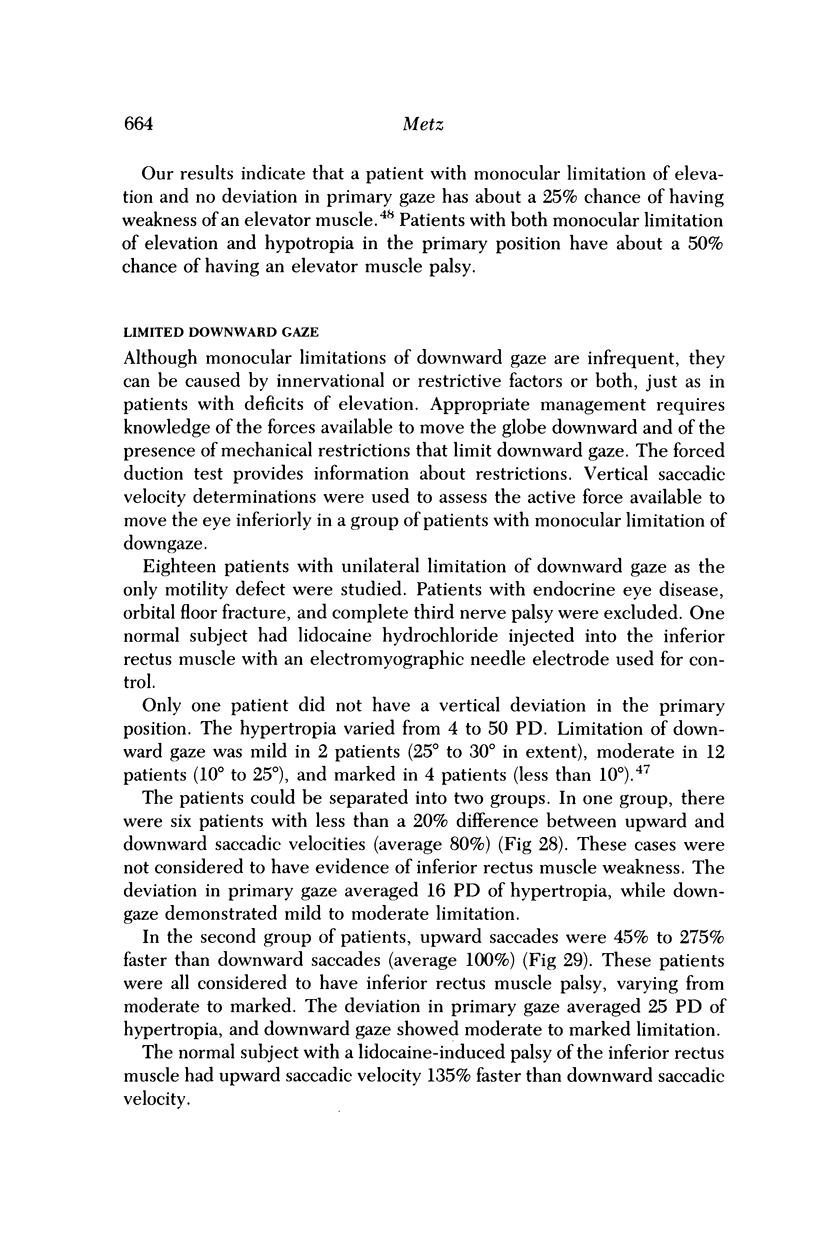
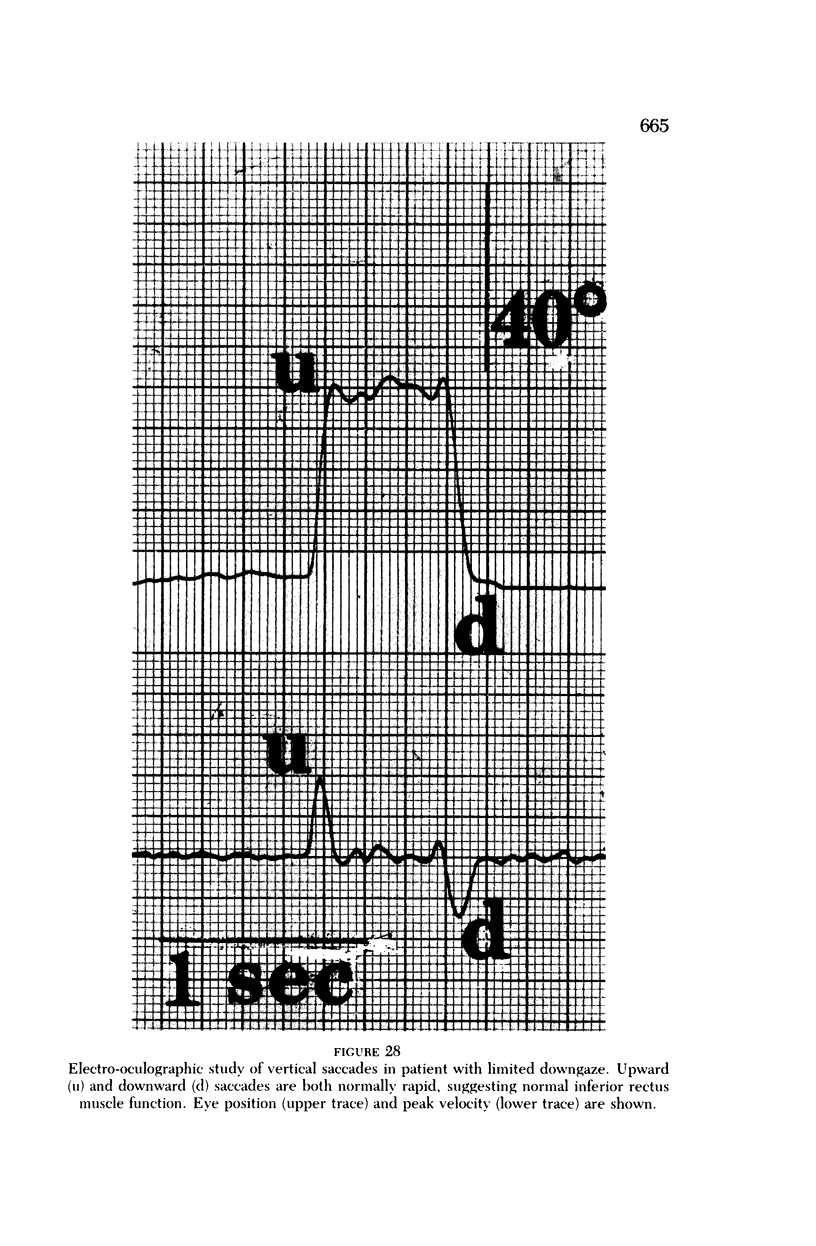
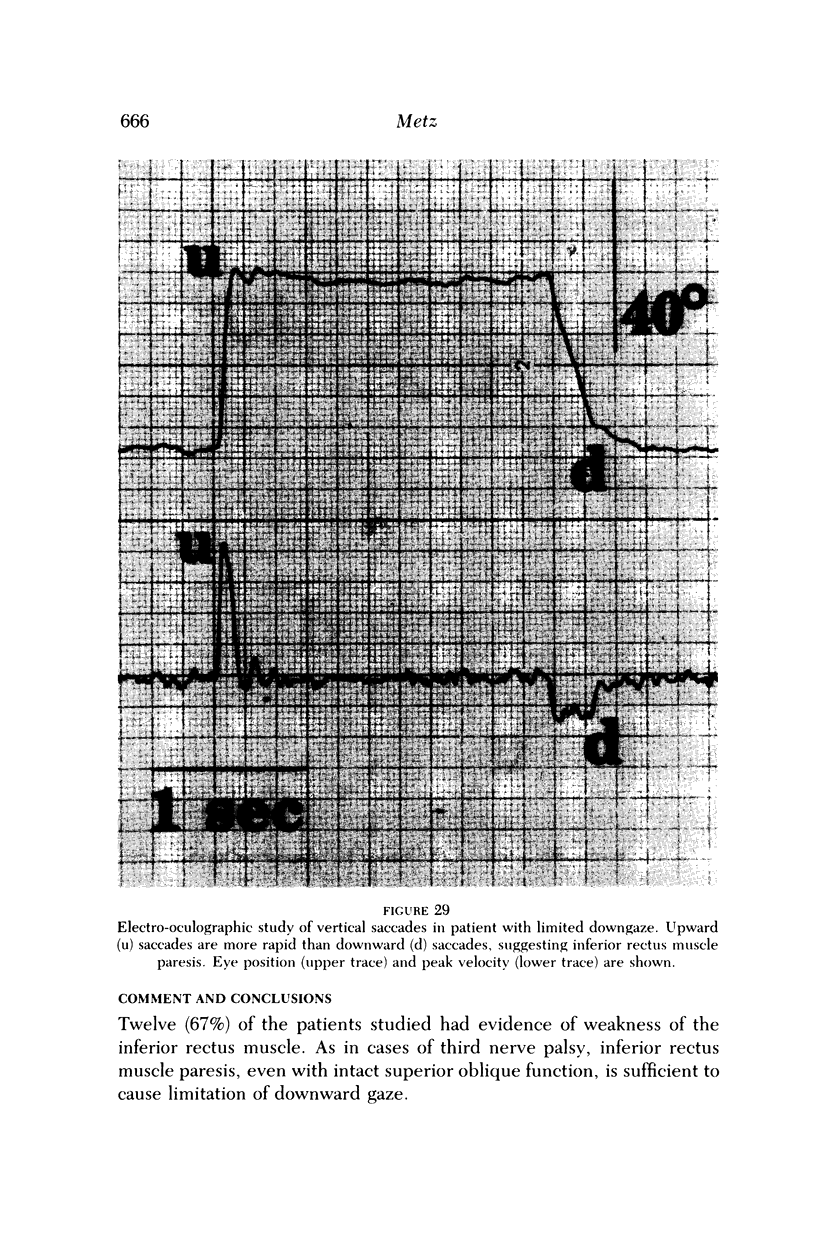
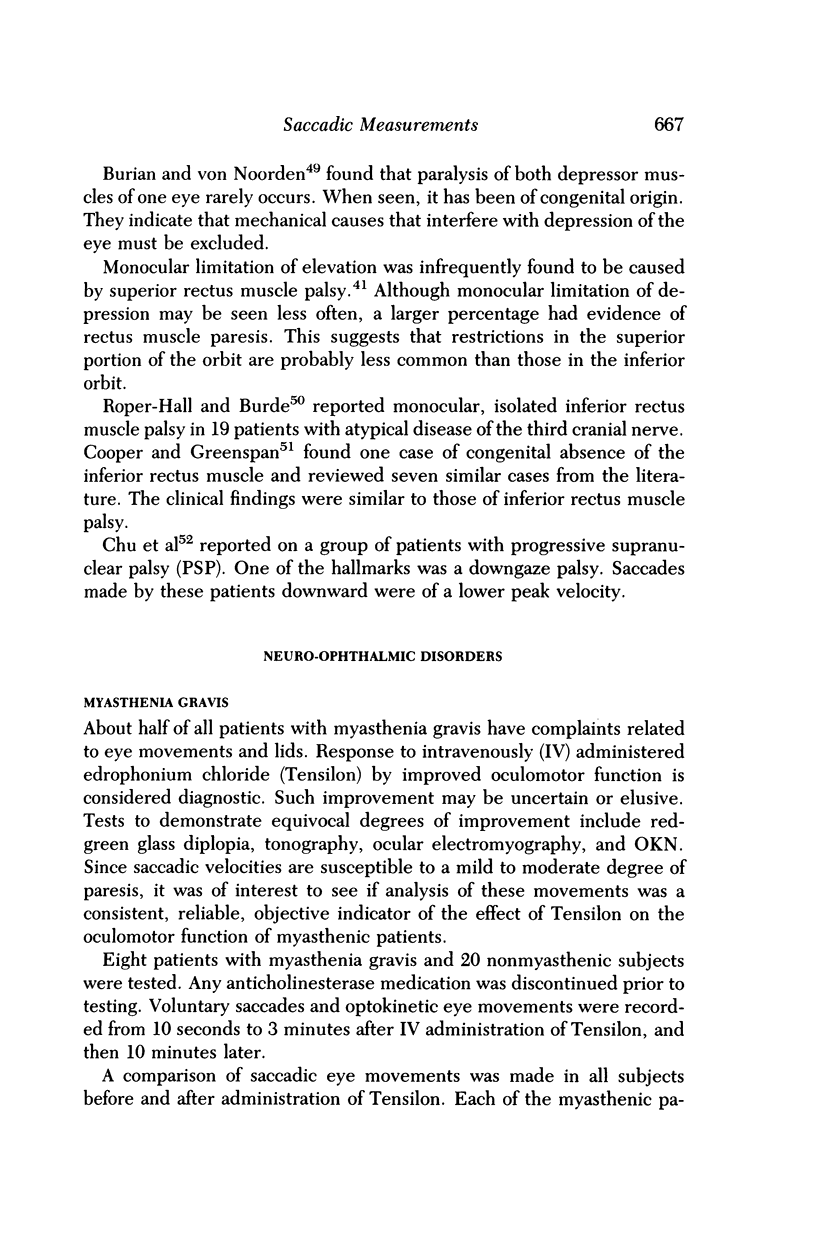
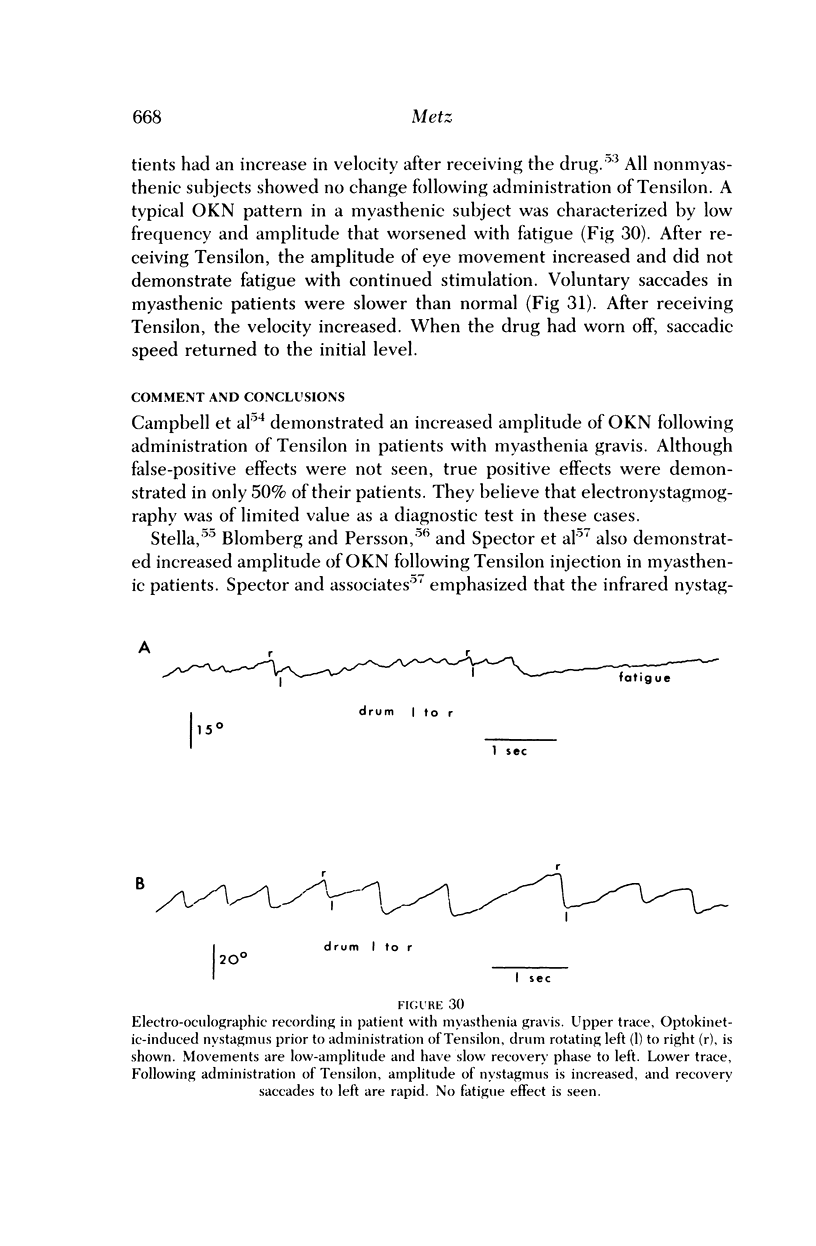
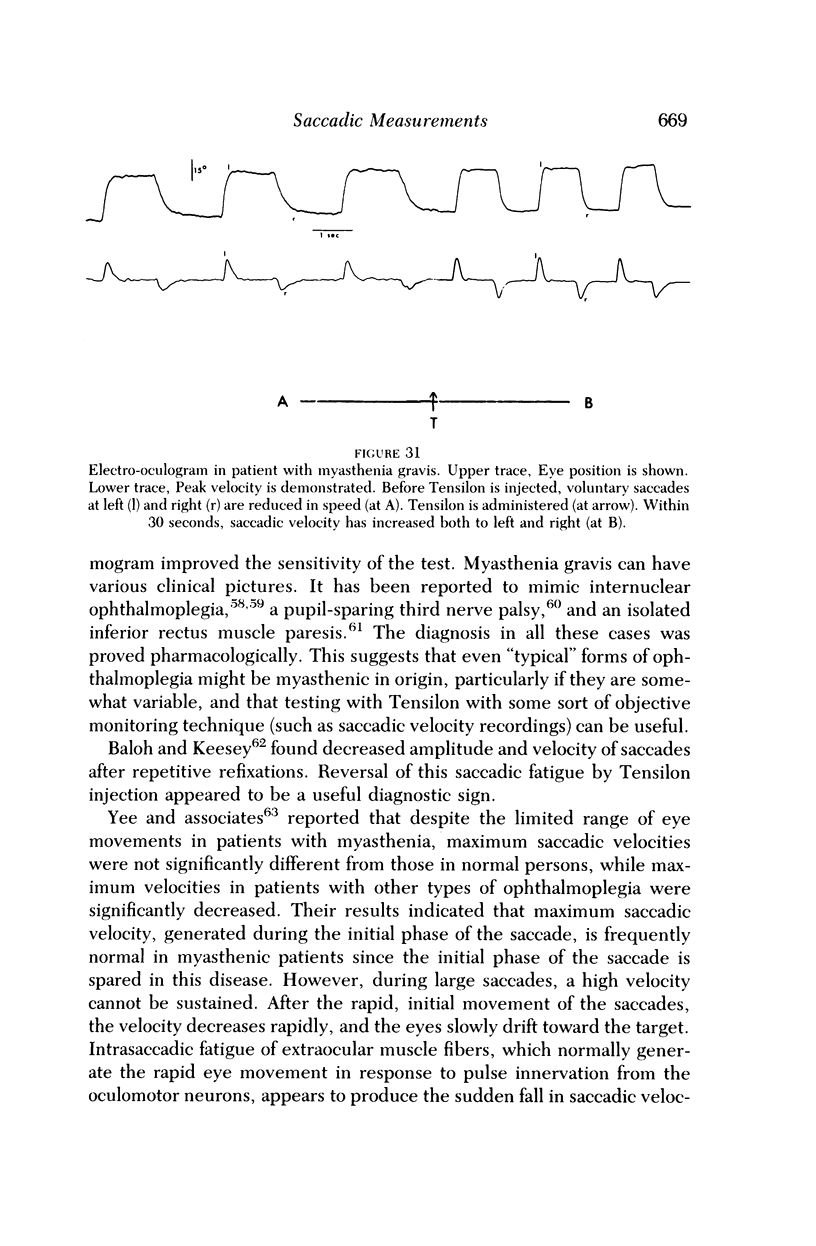
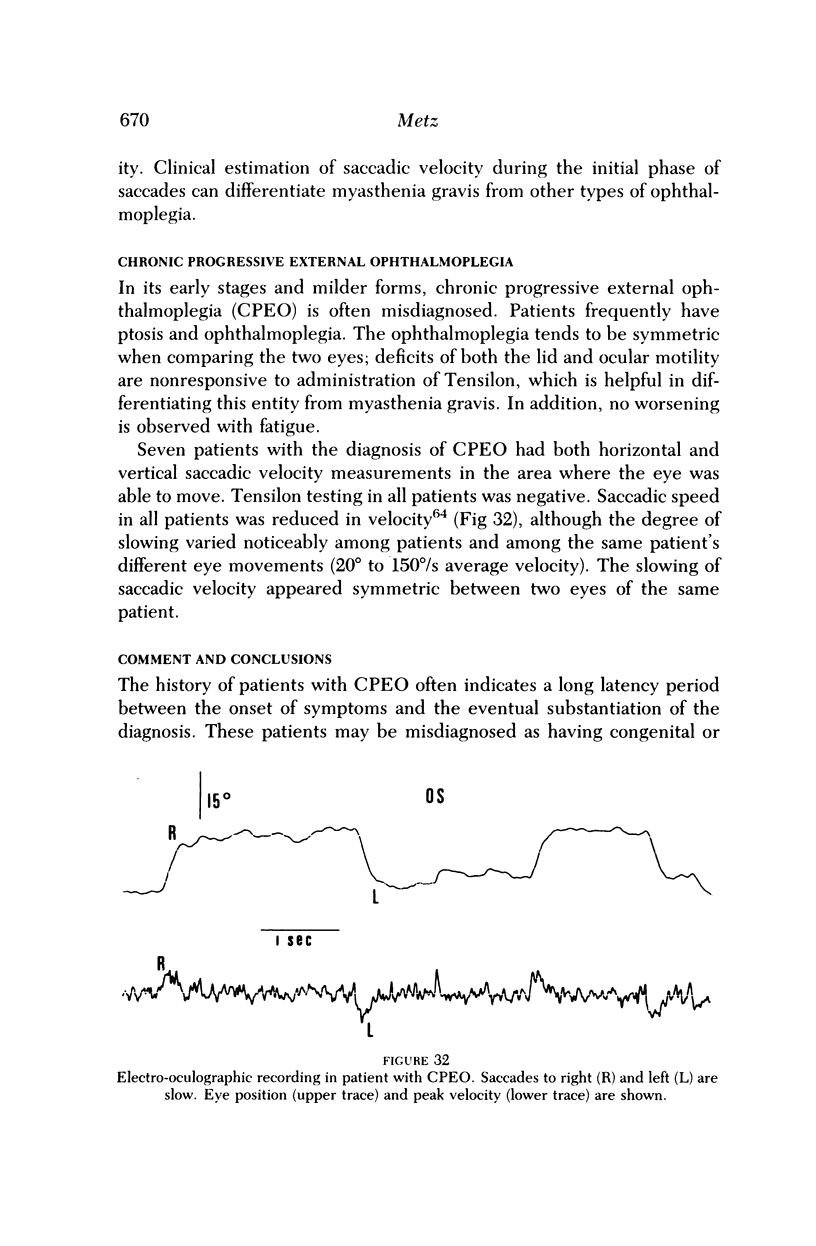
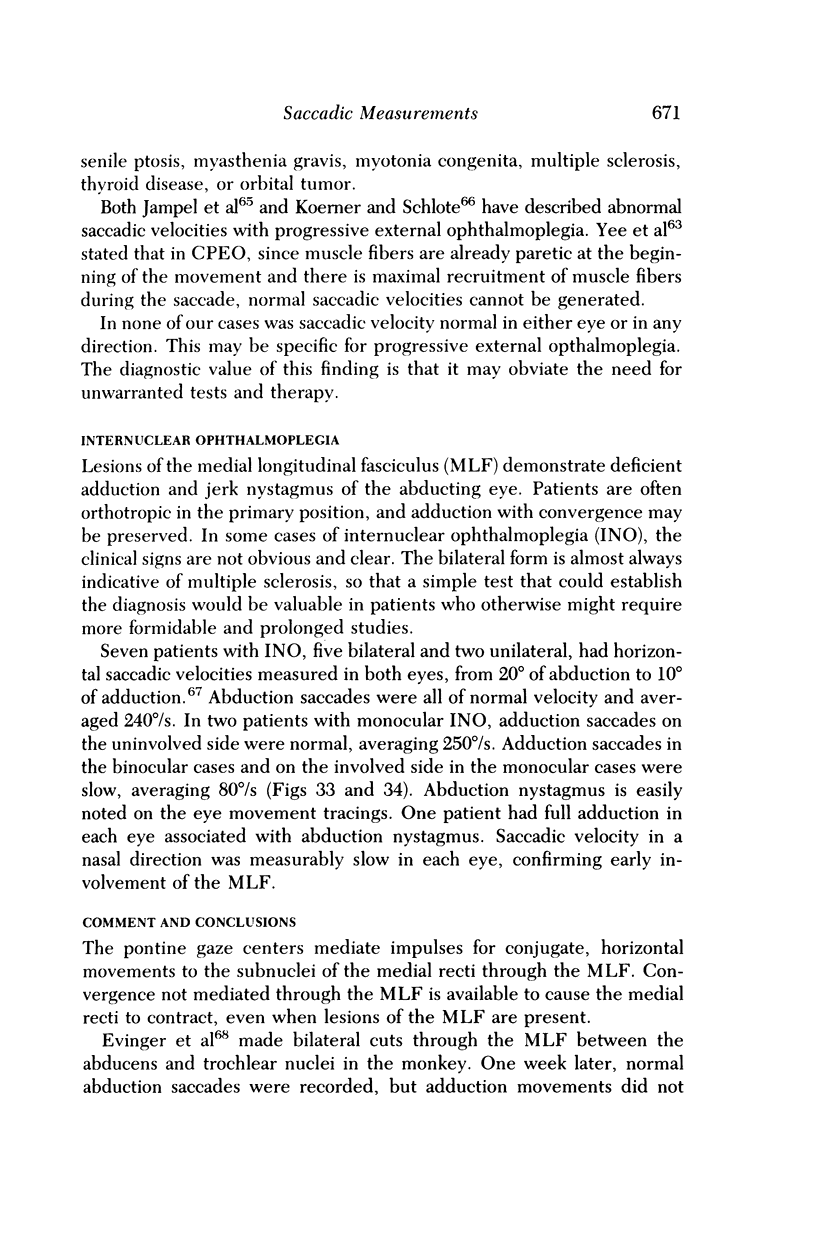
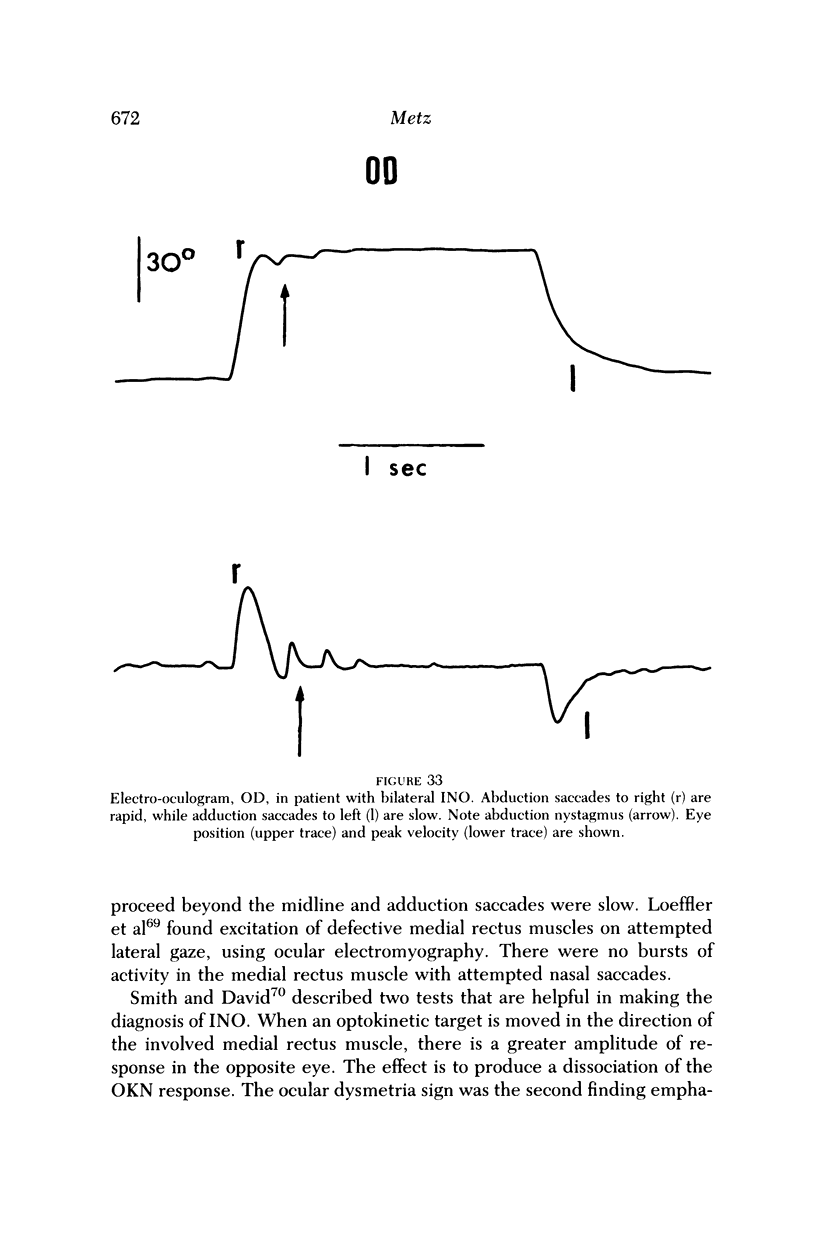
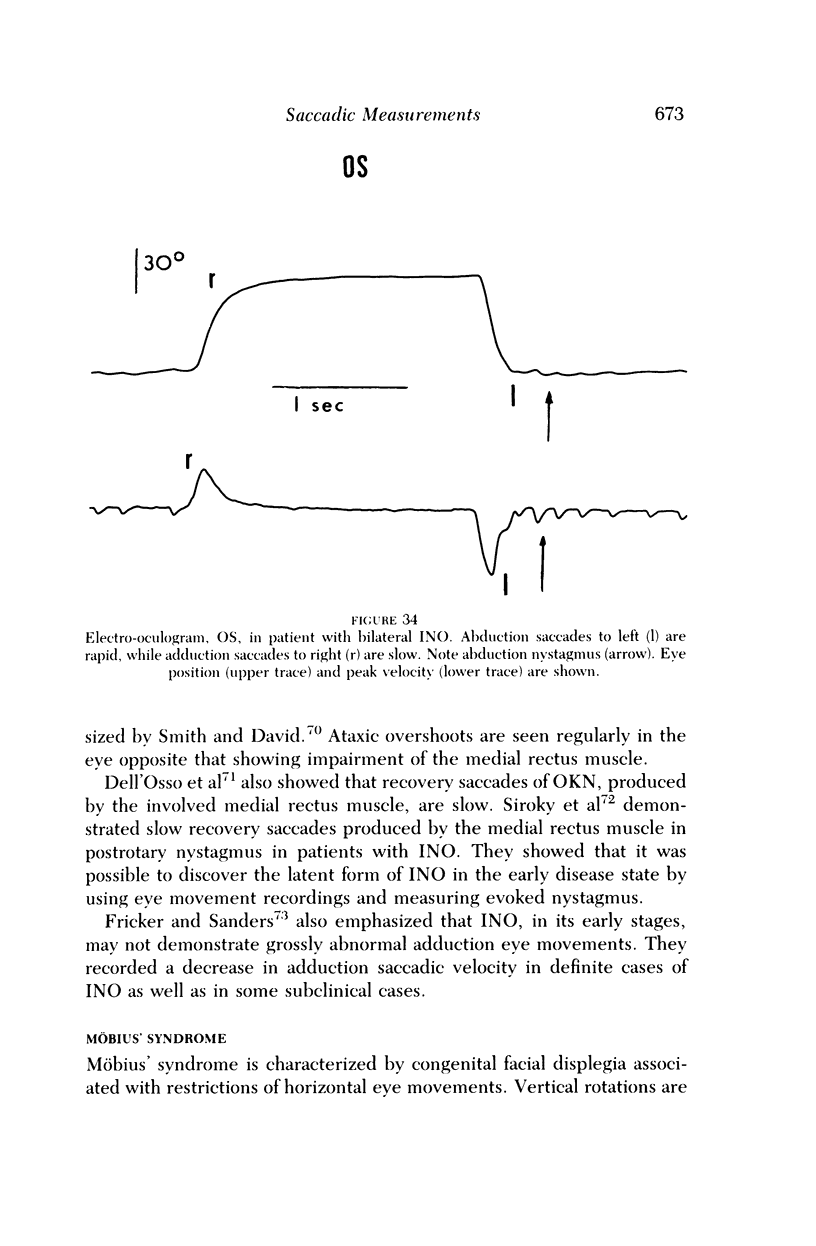
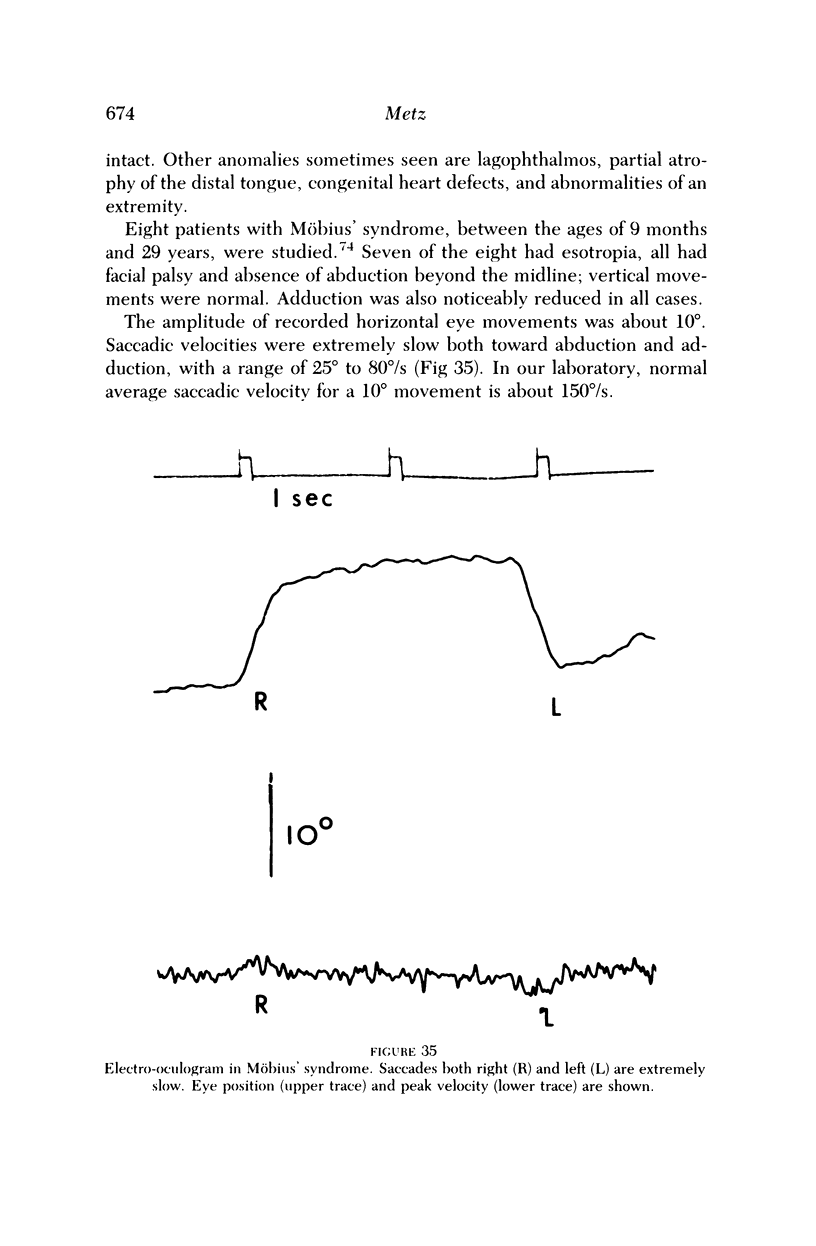
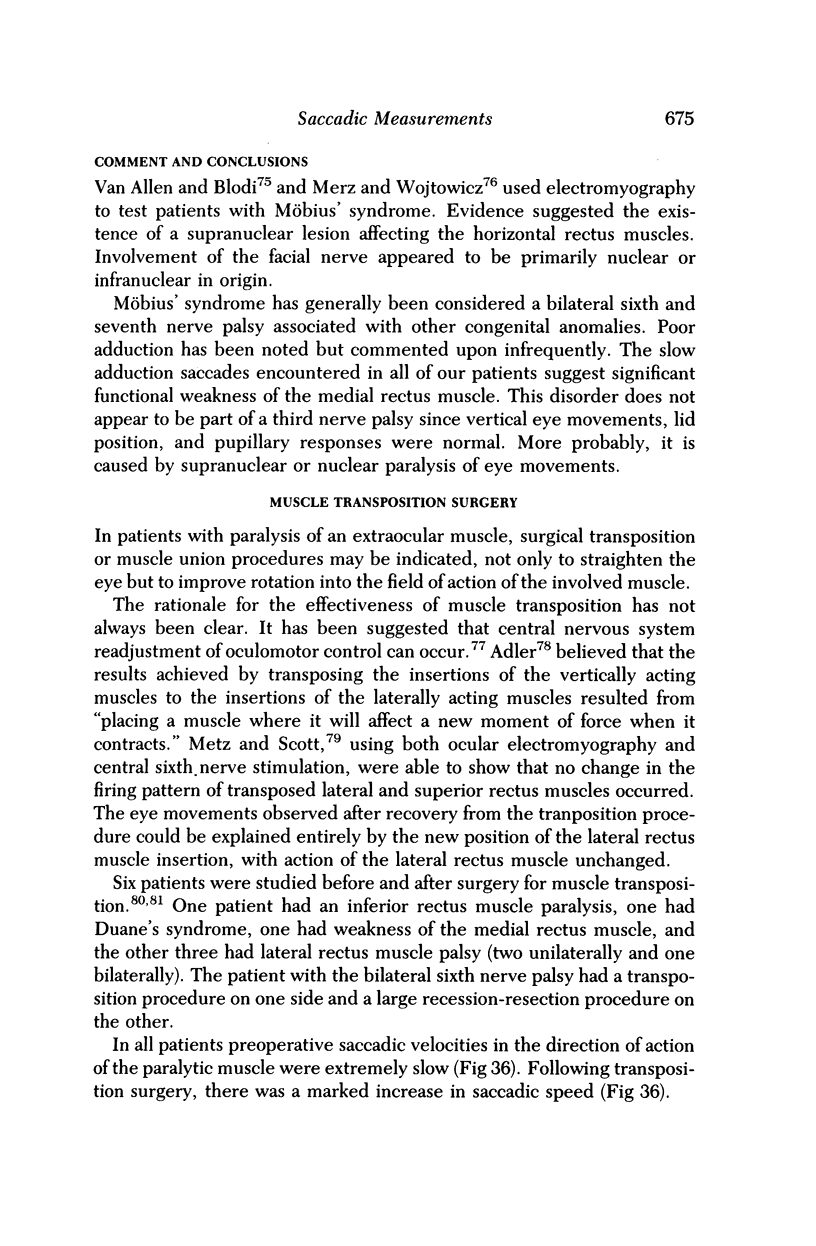
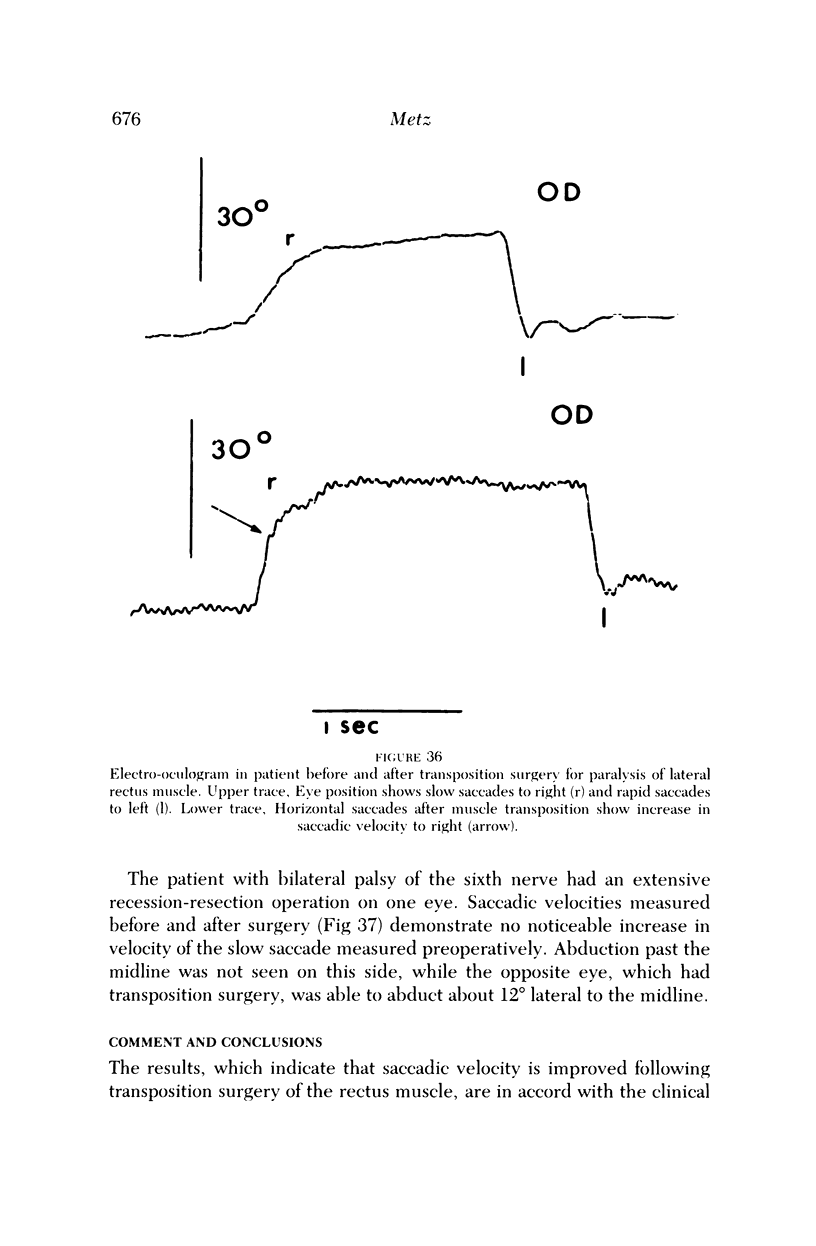

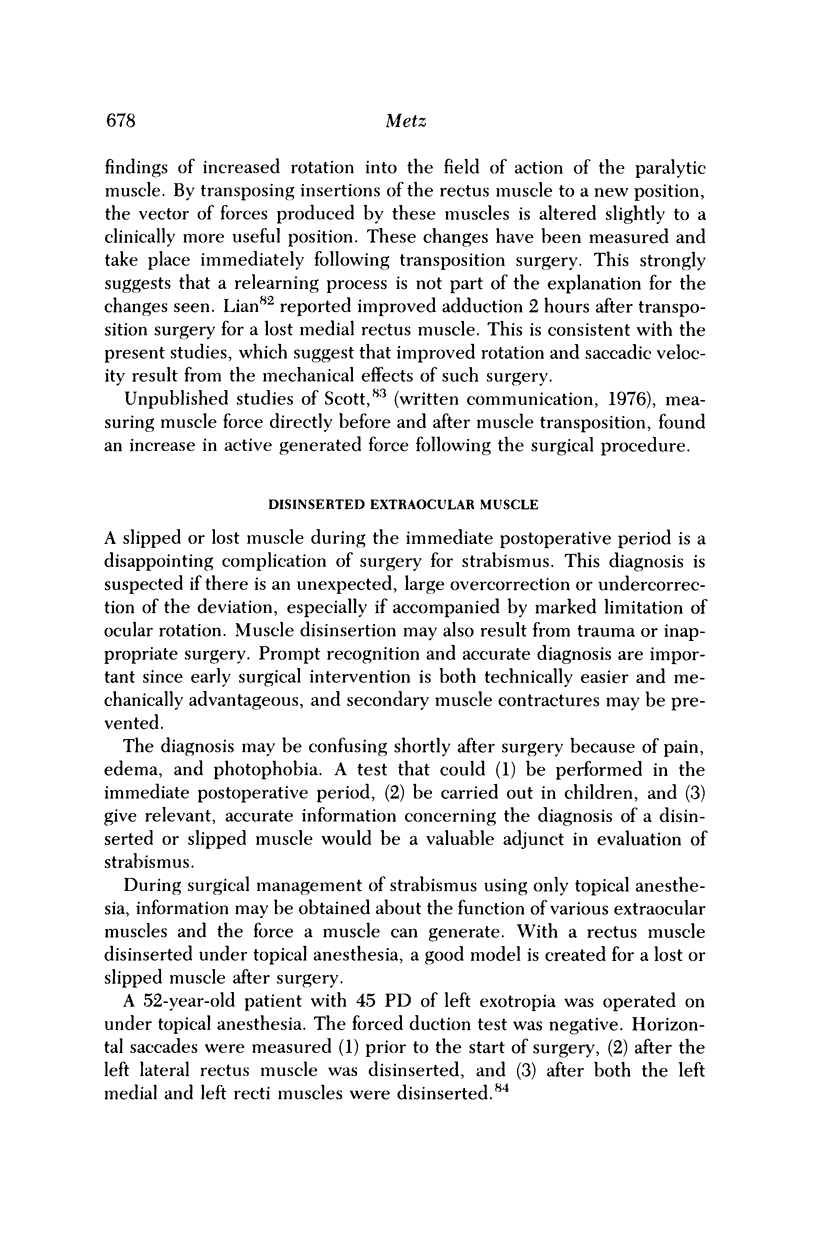
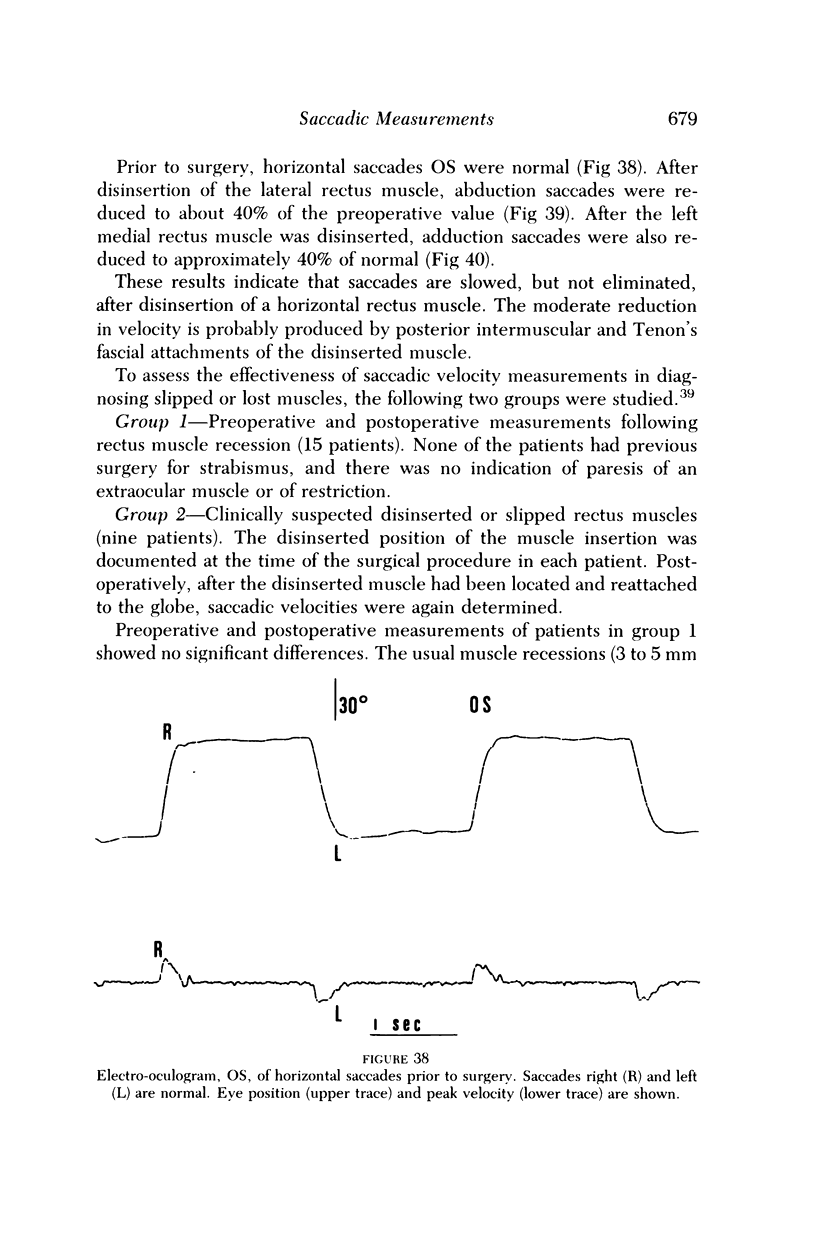
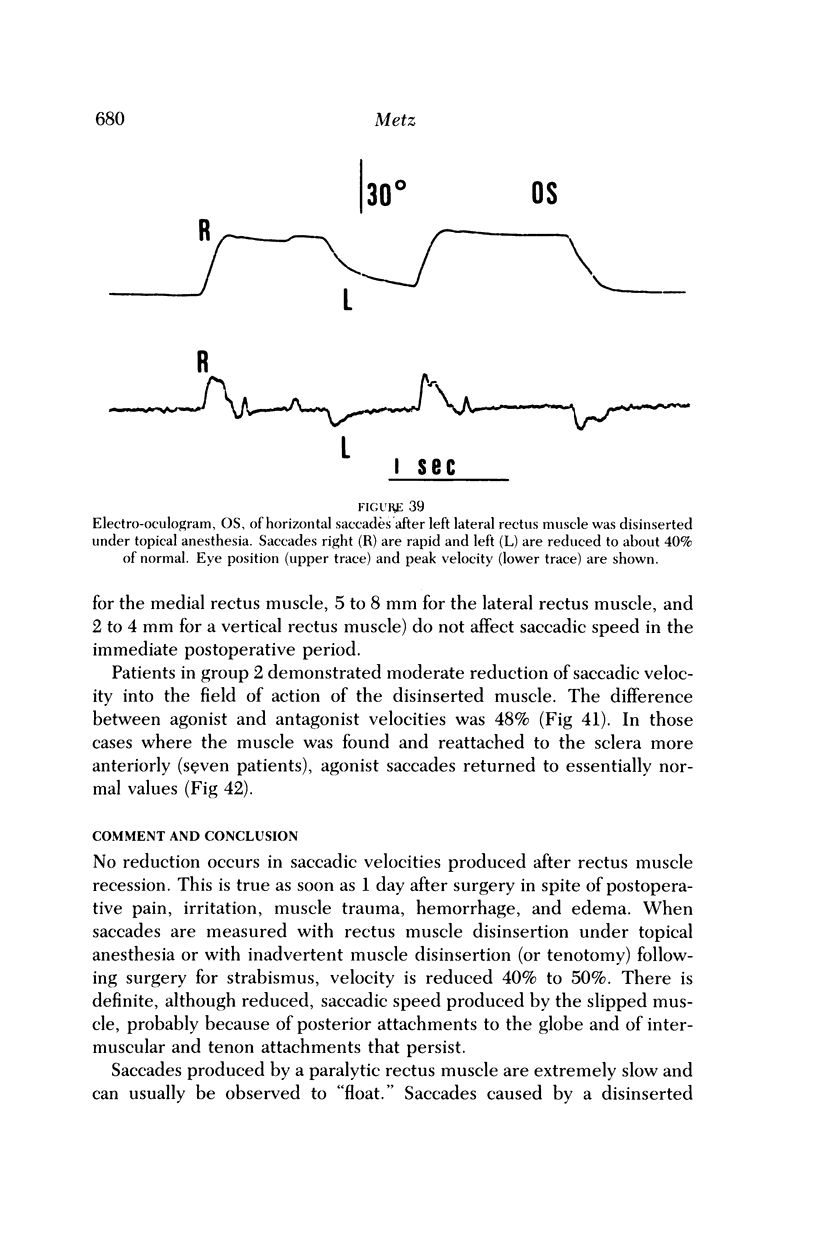
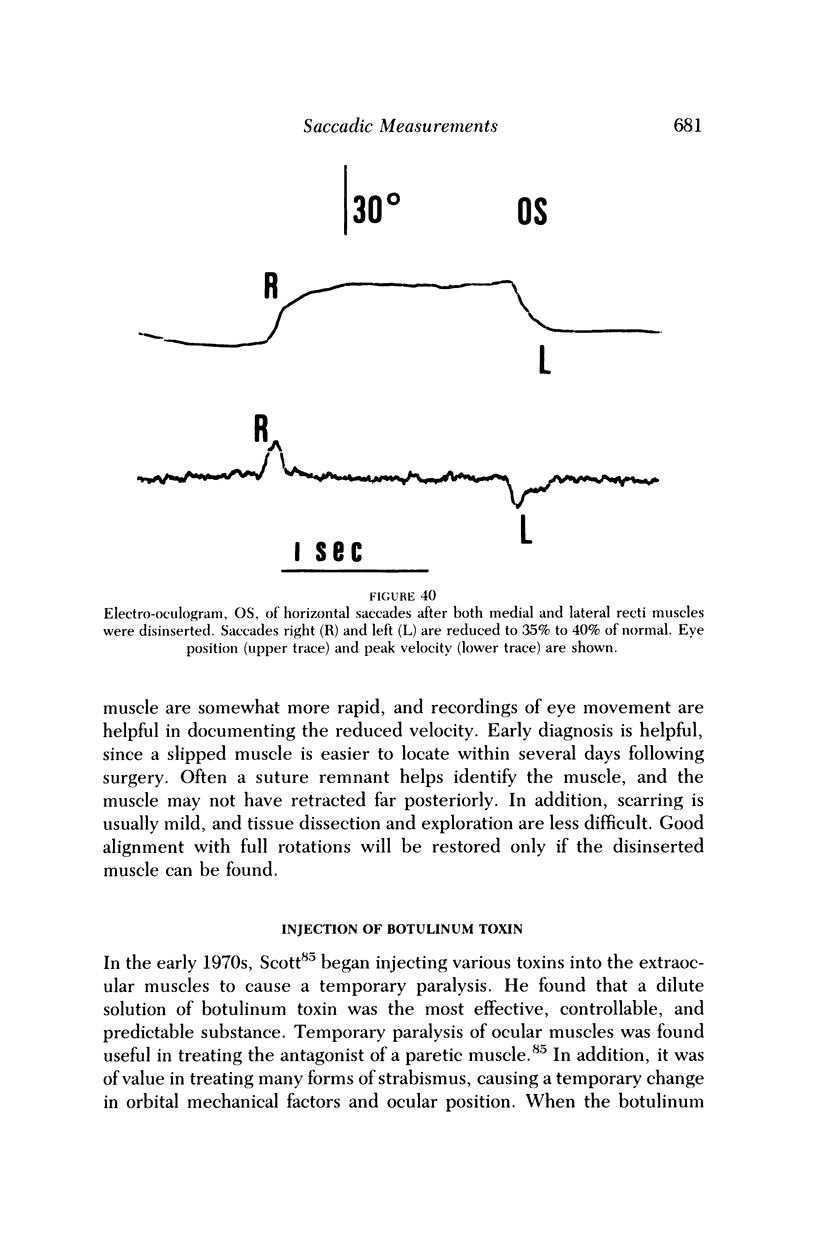
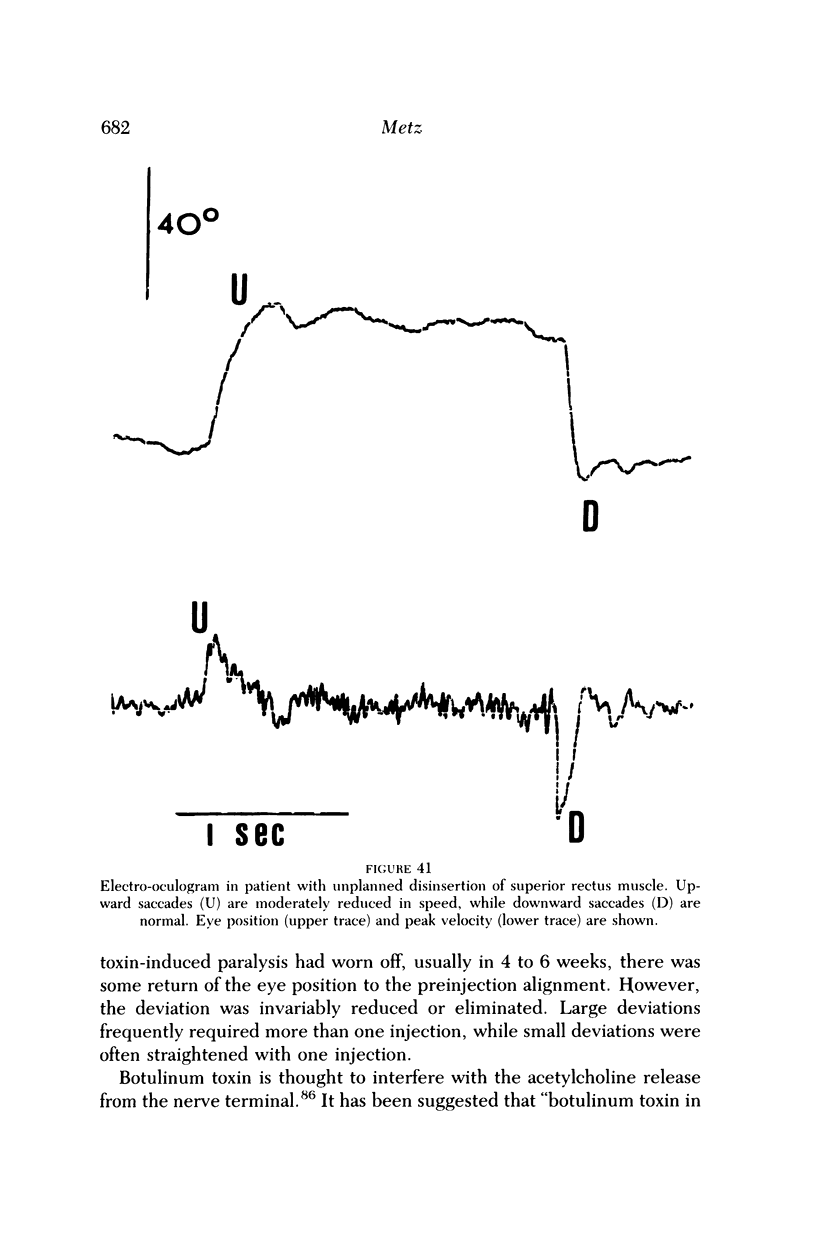

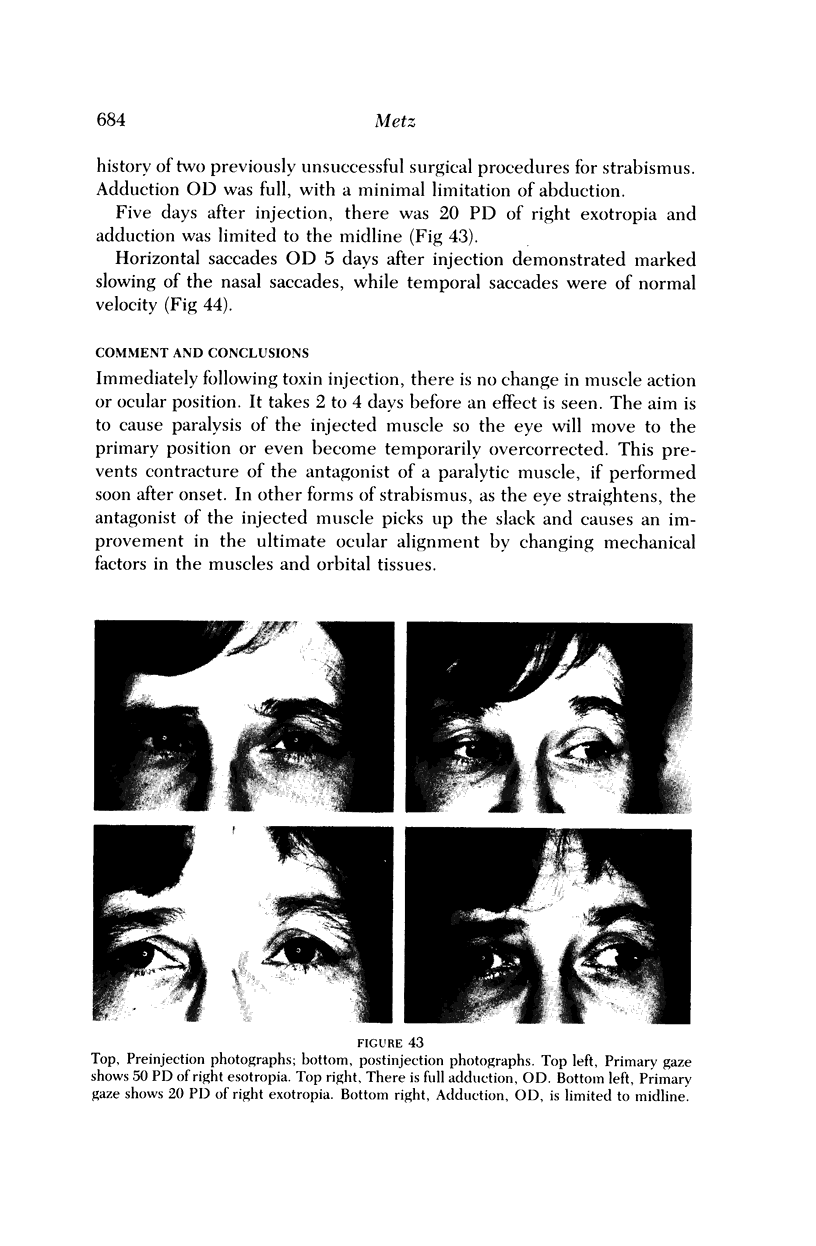
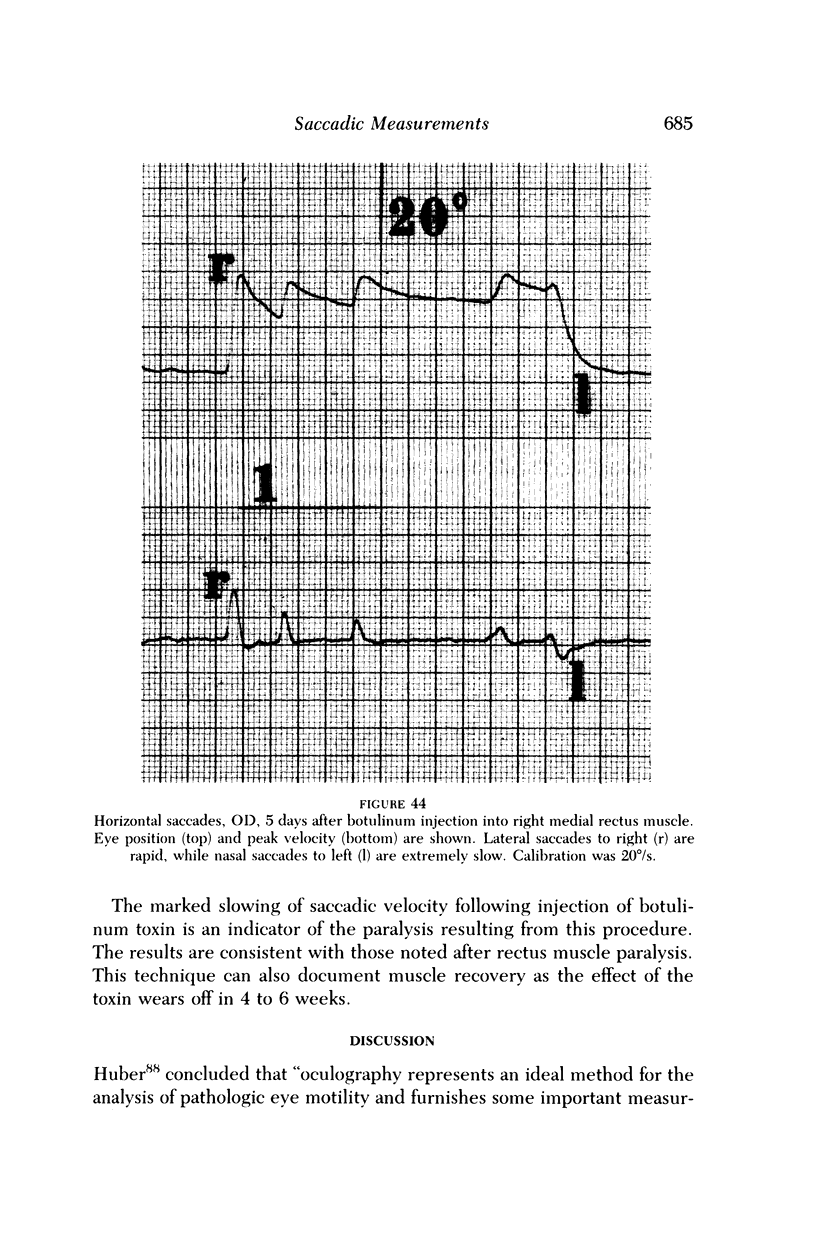

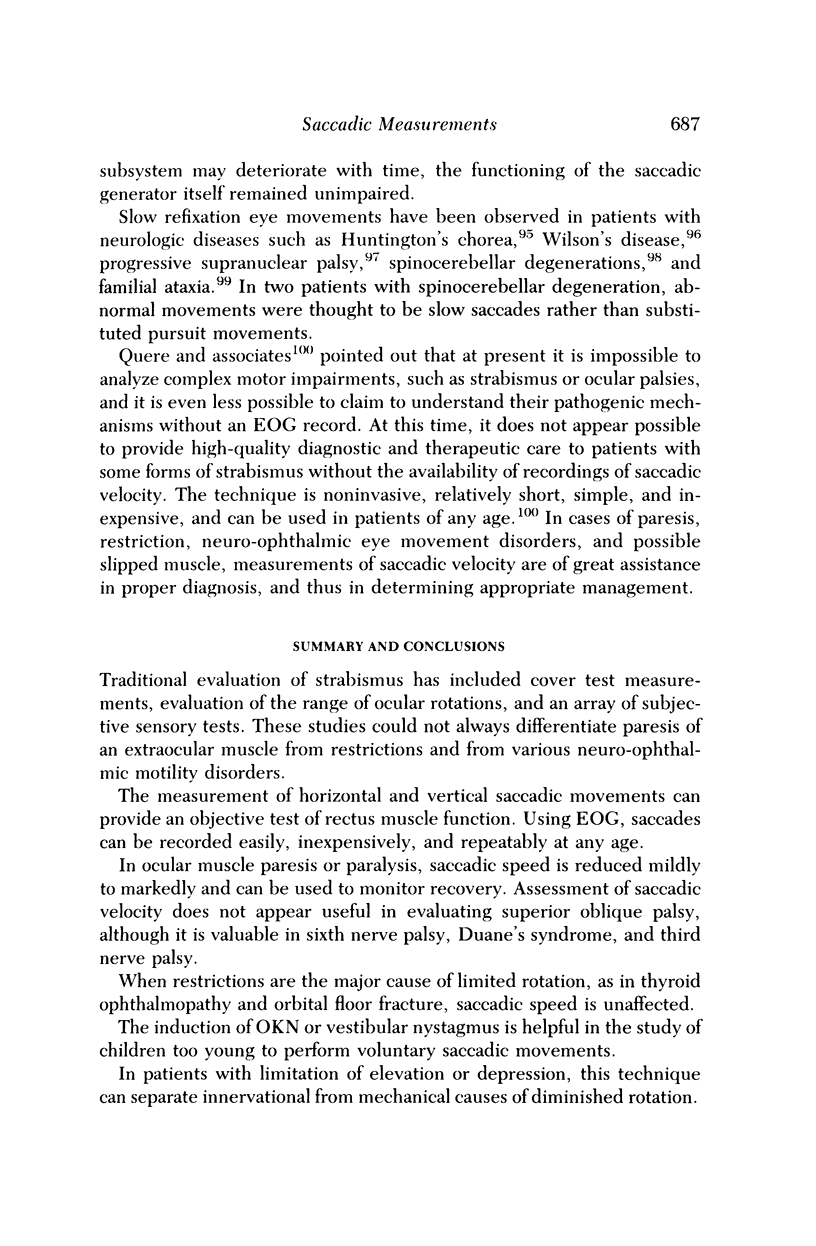
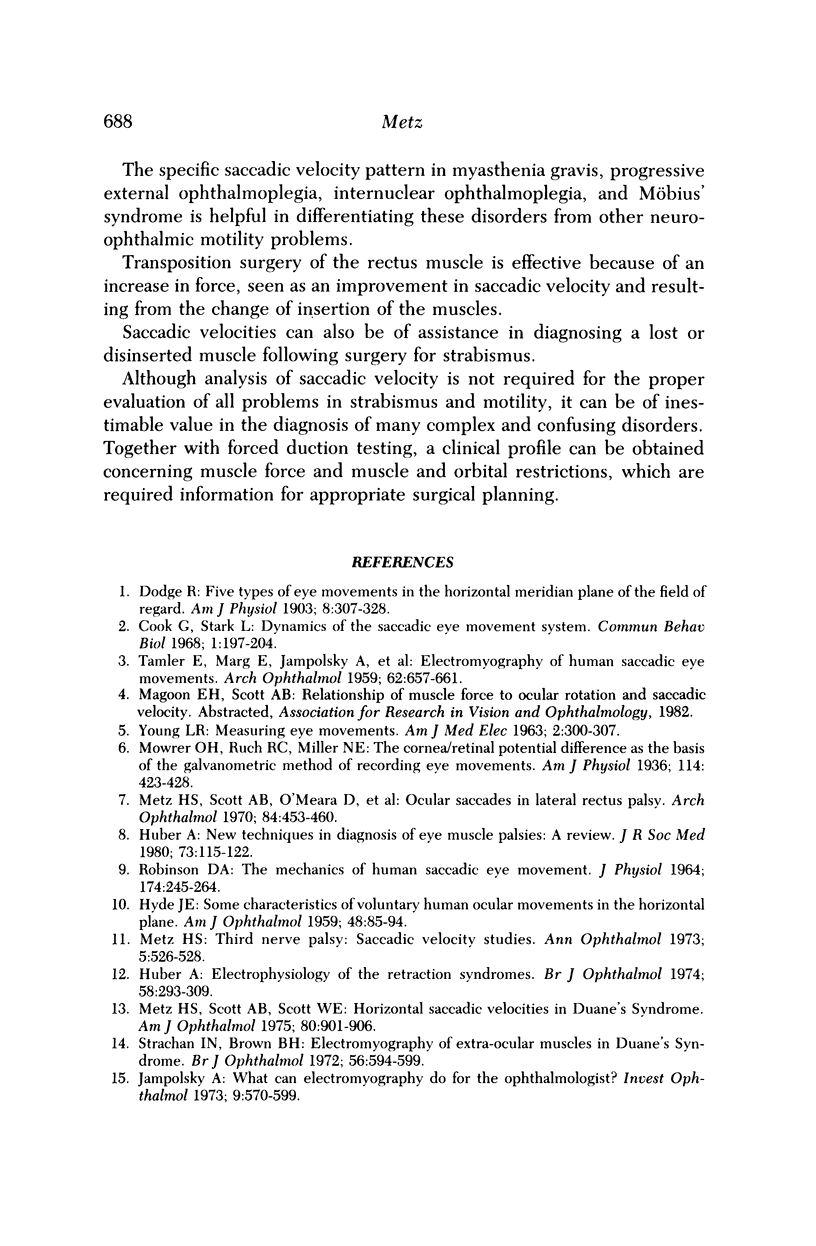
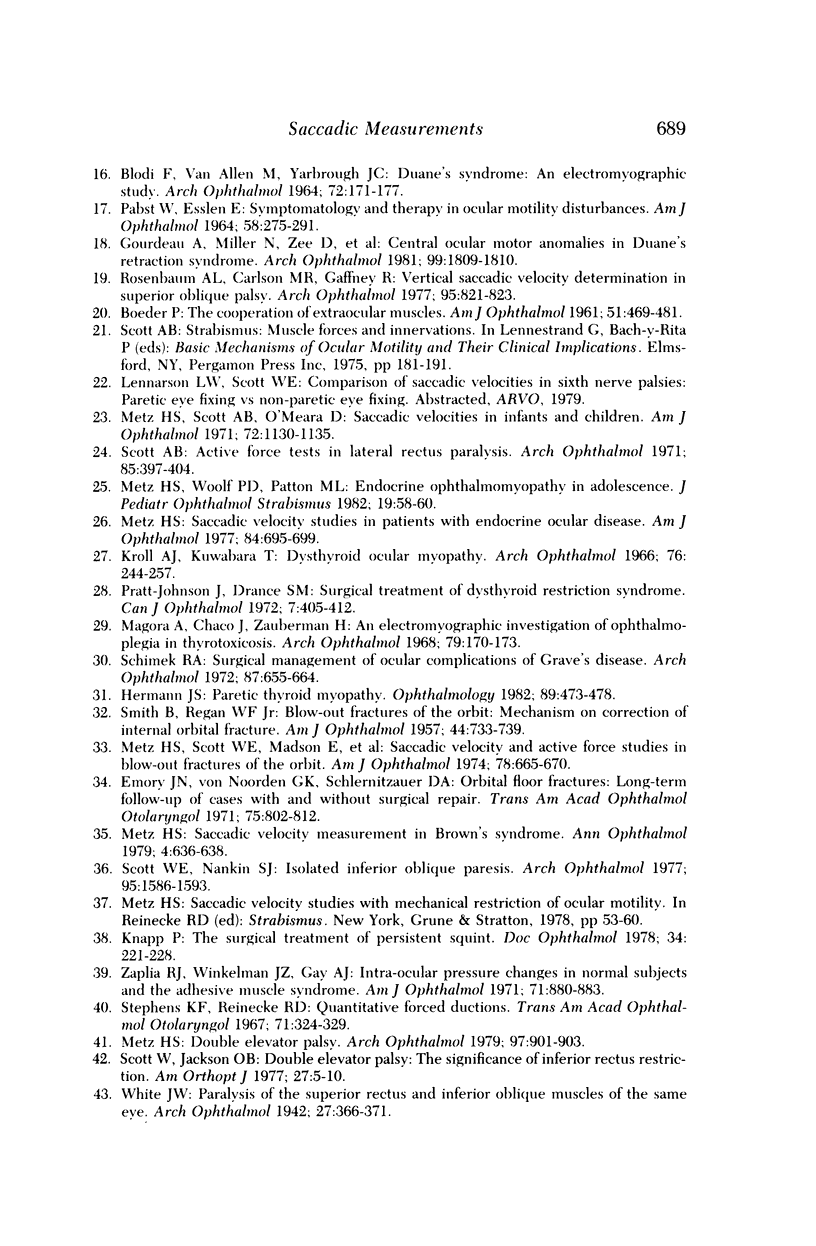
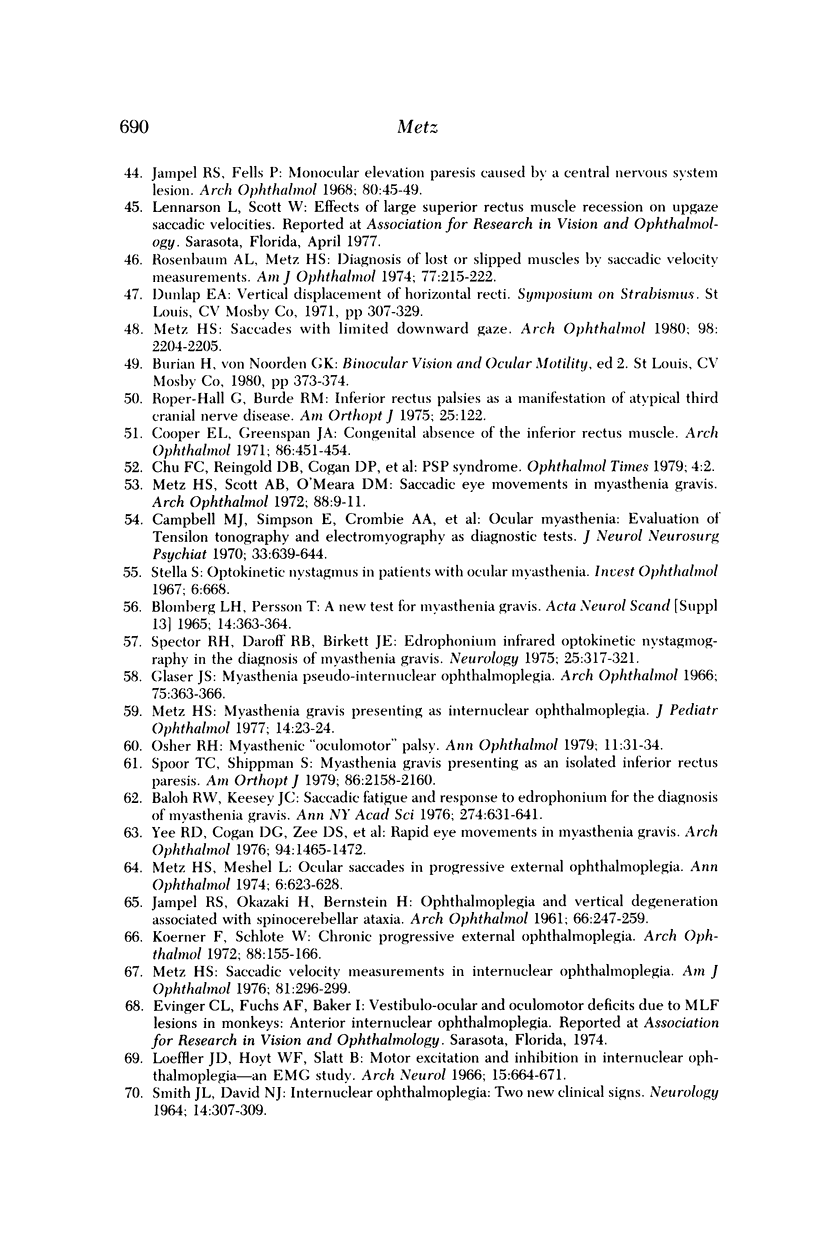
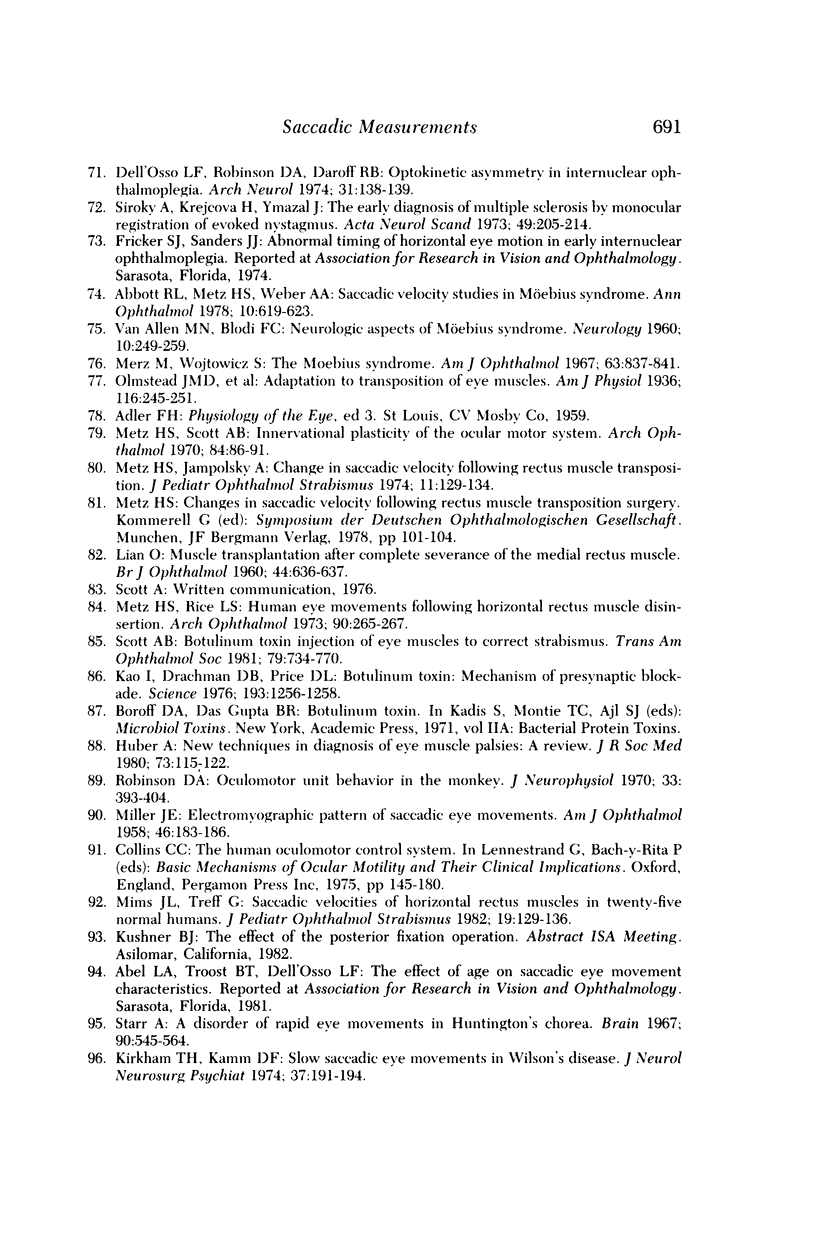

Images in this article
Selected References
These references are in PubMed. This may not be the complete list of references from this article.
- Abbott R. L., Metz H. S., Weber A. A. Saccadic velocity studies in Möbius syndrome. Ann Ophthalmol. 1978 Apr;10(5):619–623. [PubMed] [Google Scholar]
- BLODI F. C., VANALLEN M. W., YARBROUGH J. C. DUANE'S SYNDROME: A BRAIN STEM LESION. AN ELECTROMYOGRAPHIC STUDY. Arch Ophthalmol. 1964 Aug;72:171–177. doi: 10.1001/archopht.1964.00970020171007. [DOI] [PubMed] [Google Scholar]
- Baloh R. W., Keesey J. C. Saccade fatigue and response to edrophonium for the diagnosis of myasthenia gravis. Ann N Y Acad Sci. 1976;274:631–641. doi: 10.1111/j.1749-6632.1976.tb47721.x. [DOI] [PubMed] [Google Scholar]
- Blomberg L. H., Persson T. A new test for myasthenia gravis. Preliminary report. Acta Neurol Scand Suppl. 1965;13(Pt 1):363–364. doi: 10.1111/j.1600-0404.1965.tb01898.x. [DOI] [PubMed] [Google Scholar]
- Campbell M. J., Simpson E., Crombie A. L., Walton J. N. Ocular myasthenia: evaluation of Tensilon tonography and electronystagmography as diagnostic tests. J Neurol Neurosurg Psychiatry. 1970 Oct;33(5):639–646. doi: 10.1136/jnnp.33.5.639. [DOI] [PMC free article] [PubMed] [Google Scholar]
- Cooper E. L., Greenspan J. A. Congenital absence of the inferior rectus muscle. Arch Ophthalmol. 1971 Oct;86(4):451–454. doi: 10.1001/archopht.1971.01000010453018. [DOI] [PubMed] [Google Scholar]
- Dell'Osso L. F., Robinson D. A., Daroff R. B. Optokinetic asymmetry in internuclear ophthalmoplegia. Arch Neurol. 1974 Aug;31(2):138–139. doi: 10.1001/archneur.1974.00490380086012. [DOI] [PubMed] [Google Scholar]
- Emery J. M., Noorden G. K., Sclernitzauer D. A. Orbital floor fractures: long-term follow-up of cases with and without surgical repair. Trans Am Acad Ophthalmol Otolaryngol. 1971 Jul-Aug;75(4):802–812. [PubMed] [Google Scholar]
- Glaser J. S. Myasthenic psuedo-internuclear ophthalmoplegia. Arch Ophthalmol. 1966 Mar;75(3):363–366. doi: 10.1001/archopht.1966.00970050365009. [DOI] [PubMed] [Google Scholar]
- Gourdeau A., Miller N., Zee D., Morris J. Central ocular motor abnormalities in Duane's retraction syndrome. Arch Ophthalmol. 1981 Oct;99(10):1809–1810. doi: 10.1001/archopht.1981.03930020683011. [DOI] [PubMed] [Google Scholar]
- HYDE J. E. Some characteristics of voluntary human ocular movements in the horizontal plane. Am J Ophthalmol. 1959 Jul;48(1 Pt 1):85–94. doi: 10.1016/0002-9394(59)90290-9. [DOI] [PubMed] [Google Scholar]
- Hermann J. S. Paretic thyroid myopathy. Ophthalmology. 1982 May;89(5):473–478. doi: 10.1016/s0161-6420(82)34775-2. [DOI] [PubMed] [Google Scholar]
- Huber A. Electrophysiology of the retraction syndromes. Br J Ophthalmol. 1974 Mar;58(3):293–300. doi: 10.1136/bjo.58.3.293. [DOI] [PMC free article] [PubMed] [Google Scholar]
- Huber A. New techniques in diagnosis of eye muscle palsies: a review. J R Soc Med. 1980 Feb;73(2):115–122. [PMC free article] [PubMed] [Google Scholar]
- Huber A. New techniques in diagnosis of eye muscle palsies: a review. J R Soc Med. 1980 Feb;73(2):115–122. [PMC free article] [PubMed] [Google Scholar]
- JAMPEL R. S., OKAZAKI H., BERNSTEIN H. Ophthalmoplegia and retinal degeneration associated with spinocerebellar ataxia. Arch Ophthalmol. 1961 Aug;66:247–259. doi: 10.1001/archopht.1961.00960010249017. [DOI] [PubMed] [Google Scholar]
- Jampel R. S., Fells P. Monocular elevation paresis caused by a central nervous system lesion. Arch Ophthalmol. 1968 Jul;80(1):45–57. doi: 10.1001/archopht.1968.00980050047008. [DOI] [PubMed] [Google Scholar]
- Jampolsky A. What can electromyography do for the ophthalmologist? Invest Ophthalmol. 1970 Aug;9(8):570–599. [PubMed] [Google Scholar]
- Kao I., Drachman D. B., Price D. L. Botulinum toxin: mechanism of presynaptic blockade. Science. 1976 Sep 24;193(4259):1256–1258. doi: 10.1126/science.785600. [DOI] [PubMed] [Google Scholar]
- Kirkham T. H., Kamin D. F. Slow saccadic eye movements in Wilson's disease. J Neurol Neurosurg Psychiatry. 1974 Feb;37(2):191–194. doi: 10.1136/jnnp.37.2.191. [DOI] [PMC free article] [PubMed] [Google Scholar]
- Knapp P. The surgical treatment of persistent squint. Doc Ophthalmol. 1973 Feb 21;34(1):221–228. doi: 10.1007/BF00151810. [DOI] [PubMed] [Google Scholar]
- Koerner F., Schlote W. Chronic progressive external ophthalmoplegia: association with retinal pigmentary changes and evidence in favor of ocular myopathy. Arch Ophthalmol. 1972 Aug;88(2):155–166. doi: 10.1001/archopht.1972.01000030157005. [DOI] [PubMed] [Google Scholar]
- Kroll A. J., Kuwabara T. Dysthyroid ocular myopathy. Anatomy, histology, and electron microscopy. Arch Ophthalmol. 1966 Aug;76(2):244–247. doi: 10.1001/archopht.1966.03850010246017. [DOI] [PubMed] [Google Scholar]
- LIAN O. K. Muscle transplantation after a complete severance of the medial rectus muscle. Br J Ophthalmol. 1960 Oct;44:636–637. doi: 10.1136/bjo.44.10.636. [DOI] [PMC free article] [PubMed] [Google Scholar]
- Loeffler J. D., Hoyt W. F., Slatt B. Motor excitation and inhibition in internuclear palsy. An electromyographic study. Arch Neurol. 1966 Dec;15(6):664–671. doi: 10.1001/archneur.1966.00470180104012. [DOI] [PubMed] [Google Scholar]
- MILLER J. E. Electromyographic pattern of saccadic eye movements. Am J Ophthalmol. 1958 Nov;46(5 Pt 2):183–186. doi: 10.1016/0002-9394(58)90796-7. [DOI] [PubMed] [Google Scholar]
- Magora A., Chaco J., Zauberman H. An electromyographic investigation of ophthalmoplegia in thyrotoxicosis. Arch Ophthalmol. 1968 Feb;79(2):170–173. doi: 10.1001/archopht.1968.03850040172012. [DOI] [PubMed] [Google Scholar]
- Menzies R. A., Press G. D., Strehler B. L. Nucleic acid synthesis by old and young adult rat marrow cells in vitro. Biochim Biophys Acta. 1967 Aug 22;145(1):178–180. doi: 10.1016/0005-2787(67)90670-3. [DOI] [PubMed] [Google Scholar]
- Merz M., Wójtowicz S. The Möbius syndrome. Report of electromyographic examinations in two cases. Am J Ophthalmol. 1967 Apr;63(4):837–840. [PubMed] [Google Scholar]
- Metz H. S. 3. Nerve palsy. I. Saccadic velocity studies. Ann Ophthalmol. 1973 May;5(5):526–528. [PubMed] [Google Scholar]
- Metz H. S. Double elevator palsy. Arch Ophthalmol. 1979 May;97(5):901–903. doi: 10.1001/archopht.1979.01020010459013. [DOI] [PubMed] [Google Scholar]
- Metz H. S., Meshel L. Ocular saccades in progressive external ophthalmoplegia. Ann Ophthalmol. 1974 Jun;6(6):623–628. [PubMed] [Google Scholar]
- Metz H. S. Myasthenia gravis presenting as internuclear ophthalmoplegia. J Pediatr Ophthalmol. 1977 Jan-Feb;14(1):23–24. [PubMed] [Google Scholar]
- Metz H. S., Rice L. S. Human eye movements following horizontal rectus muscle disinsertion. Arch Ophthalmol. 1973 Oct;90(4):265–267. doi: 10.1001/archopht.1973.01000050267001. [DOI] [PubMed] [Google Scholar]
- Metz H. S. Saccades with limited downward gaze. Arch Ophthalmol. 1980 Dec;98(12):2204–2205. doi: 10.1001/archopht.1980.01020041056011. [DOI] [PubMed] [Google Scholar]
- Metz H. S. Saccadic velocity measurements in Brown's syndrome. Ann Ophthalmol. 1979 Apr;11(4):636–638. [PubMed] [Google Scholar]
- Metz H. S. Saccadic velocity measurements in internuclear ophthalmoplegia. Am J Ophthalmol. 1976 Mar;81(3):296–299. doi: 10.1016/0002-9394(76)90243-9. [DOI] [PubMed] [Google Scholar]
- Metz H. S. Saccadic velocity studies in patients with endocrine ocular disease. Am J Ophthalmol. 1977 Nov;84(5):695–699. doi: 10.1016/0002-9394(77)90386-5. [DOI] [PubMed] [Google Scholar]
- Metz H. S., Scott A. B. Innervational plasticity of the oculomotor system. Arch Ophthalmol. 1970 Jul;84(1):86–91. doi: 10.1001/archopht.1970.00990040088021. [DOI] [PubMed] [Google Scholar]
- Metz H. S., Scott A. B., O'Meara D. M. Saccadic eye movements in myasthenia gravis. Arch Ophthalmol. 1972 Jul;88(1):9–11. doi: 10.1001/archopht.1972.01000030011003. [DOI] [PubMed] [Google Scholar]
- Metz H. S., Scott A. B., O'Meara D. Saccadic velocities in infants and children. Am J Ophthalmol. 1971 Dec;72(6):1130–1135. doi: 10.1016/0002-9394(71)91220-7. [DOI] [PubMed] [Google Scholar]
- Metz H. S., Scott A. B., O'Meara D., Stewart H. L. Ocular saccades in lateral rectus palsy. Arch Ophthalmol. 1970 Oct;84(4):453–460. doi: 10.1001/archopht.1970.00990040455010. [DOI] [PubMed] [Google Scholar]
- Metz H. S., Scott A. B., Scott W. E. Horizontal saccadic velocities in Duane's syndrome. Am J Ophthalmol. 1975 Nov;80(5):901–906. doi: 10.1016/0002-9394(75)90287-1. [DOI] [PubMed] [Google Scholar]
- Metz H. S., Scott W. E., Madson E., Scott A. B. Saccadic velocity and active force studies in blow-out fractures of the orbit. Am J Ophthalmol. 1974 Oct;78(4):665–670. doi: 10.1016/s0002-9394(14)76305-6. [DOI] [PubMed] [Google Scholar]
- Metz H. S., Woolf P. D., Patton M. L. Endocrine ophthalmomyopathy in adolescence. J Pediatr Ophthalmol Strabismus. 1982 Jan-Feb;19(1):58–60. doi: 10.3928/0191-3913-19820101-14. [DOI] [PubMed] [Google Scholar]
- Mims J. L., 3rd, Treff G. Saccadic velocities of horizontal rectus muscles in twenty-five normal humans. J Pediatr Ophthalmol Strabismus. 1982 May-Jun;19(3):129–136. doi: 10.3928/0191-3913-19820501-04. [DOI] [PubMed] [Google Scholar]
- Murphy M. J., Goldblatt D. Slow eye movements, with absent saccades, in a patient with hereditary ataxia. Arch Neurol. 1977 Mar;34(3):191–195. doi: 10.1001/archneur.1977.00500150077016. [DOI] [PubMed] [Google Scholar]
- Newman N., Gay A. J., Stroud M. H., Brooks J. Defective rapid eye movements in progressive supranuclear palsy. An ocular electromyographic study. Brain. 1970;93(4):775–784. doi: 10.1093/brain/93.4.775. [DOI] [PubMed] [Google Scholar]
- Osher R. H. Myasthenic "oculomotor" palsy. Ann Ophthalmol. 1979 Jan;11(1):31–34. [PubMed] [Google Scholar]
- Pratt-Johnson J. A., Drance S. M. Surgical treatment of dysthyroid restriction syndromes. Can J Ophthalmol. 1972 Oct;7(4):405–412. [PubMed] [Google Scholar]
- Quéré M. A., Péchereau A., Lavenant F. Kinetic electro-oculography: aims - disadvantages and limitations. Ophthalmologica. 1981;182(2):73–80. doi: 10.1159/000309095. [DOI] [PubMed] [Google Scholar]
- ROBINSON D. A. THE MECHANICS OF HUMAN SACCADIC EYE MOVEMENT. J Physiol. 1964 Nov;174:245–264. doi: 10.1113/jphysiol.1964.sp007485. [DOI] [PMC free article] [PubMed] [Google Scholar]
- Robinson D. A. Oculomotor unit behavior in the monkey. J Neurophysiol. 1970 May;33(3):393–403. doi: 10.1152/jn.1970.33.3.393. [DOI] [PubMed] [Google Scholar]
- Roper-Hall G., Burde R. M. Inferior rectus palsies as a manifestation of atypical IIIrd cranial nerve disease. Am Orthopt J. 1975;25:122–130. [PubMed] [Google Scholar]
- Rosenbaum A. L., Carlson M. R., Gaffney R. Vertical saccadic velocity determination in superior oblique palsy. Arch Ophthalmol. 1977 May;95(5):821–823. doi: 10.1001/archopht.1977.04450050099011. [DOI] [PubMed] [Google Scholar]
- Rosenbaum A. L., Metz H. S. Diagnosis of lost or slipped muscle by saccadic velocity measurements. Am J Ophthalmol. 1974 Feb;77(2):215–222. doi: 10.1016/0002-9394(74)90676-x. [DOI] [PubMed] [Google Scholar]
- SMITH B., REGAN W. F., Jr Blow-out fracture of the orbit; mechanism and correction of internal orbital fracture. Am J Ophthalmol. 1957 Dec;44(6):733–739. doi: 10.1016/0002-9394(76)90774-1. [DOI] [PubMed] [Google Scholar]
- SMITH J. L., DAVID N. J. INTERNUCLEAR OPHTHALMOPLEGIA. TWO NEW CLINICAL SIGNS. Neurology. 1964 Apr;14:307–309. doi: 10.1212/wnl.14.4.307. [DOI] [PubMed] [Google Scholar]
- Schimek R. A. Surgical management of ocular complications of Graves' disease. Arch Ophthalmol. 1972 Jun;87(6):655–664. doi: 10.1001/archopht.1972.01000020657009. [DOI] [PubMed] [Google Scholar]
- Scott A. B. Active force tests in lateral rectus paralysis. Arch Ophthalmol. 1971 Apr;85(4):397–404. doi: 10.1001/archopht.1971.00990050399001. [DOI] [PubMed] [Google Scholar]
- Scott A. B. Botulinum toxin injection of eye muscles to correct strabismus. Trans Am Ophthalmol Soc. 1981;79:734–770. [PMC free article] [PubMed] [Google Scholar]
- Scott W. E., Jackson O. B. Double elevator palsy: the significance of inferior rectus restriction. Am Orthopt J. 1977;27:5–10. [PubMed] [Google Scholar]
- Scott W. E., Nankin S. J. Isolated inferior oblique paresis. Arch Ophthalmol. 1977 Sep;95(9):1586–1593. doi: 10.1001/archopht.1977.04450090108009. [DOI] [PubMed] [Google Scholar]
- Singh B. M., Ivamoto H., Strobos R. J. Slow eye movements in spinocerebellar degeneration. Am J Ophthalmol. 1973 Aug;76(2):237–240. doi: 10.1016/0002-9394(73)90167-0. [DOI] [PubMed] [Google Scholar]
- Siroký A., Krejcová H., Vymazal J. The early diagnosis of multiple sclerosis by monocular registration of evoked nystagmus. Acta Neurol Scand. 1973;49(2):205–214. doi: 10.1111/j.1600-0404.1973.tb01292.x. [DOI] [PubMed] [Google Scholar]
- Spector R. H., Daroff R. B., Birkett J. E. Edrophonium infrared optokinetic nystagmography in the diagnosis of myasthenia gravis. Neurology. 1975 Apr;25(4):317–321. doi: 10.1212/wnl.25.4.317. [DOI] [PubMed] [Google Scholar]
- Spoor T. C., Shippman S. Myasthenia gravis presenting as an isolated inferior rectus paresis. Ophthalmology. 1979 Dec;86(12):2158–2160. doi: 10.1016/s0161-6420(79)35294-0. [DOI] [PubMed] [Google Scholar]
- Starr A. A disorder of rapid eye movements in Huntington's chorea. Brain. 1967 Sep;90(3):545–564. doi: 10.1093/brain/90.3.545. [DOI] [PubMed] [Google Scholar]
- Stephens K. F., Reinecke R. D. Quantitative forced duction. Trans Am Acad Ophthalmol Otolaryngol. 1967 Mar-Apr;71(2):324–329. [PubMed] [Google Scholar]
- Strachan I. M., Brown B. H. Electromyography of extraocular muscles in Duane's syndrome. Br J Ophthalmol. 1972 Aug;56(8):594–599. doi: 10.1136/bjo.56.8.594. [DOI] [PMC free article] [PubMed] [Google Scholar]
- VAN ALLEN M. W., BLODI F. C. Neurologic aspects of the Mobius syndrome. A case study with electromyography of the extraocular and facial muscles. Neurology. 1960 Mar;10:249–259. doi: 10.1212/wnl.10.3.249. [DOI] [PubMed] [Google Scholar]
- YOUNG L. R. MEASURING EYE MOVEMENTS. Am J Med Electron. 1963 Oct-Dec;2:300–307. [PubMed] [Google Scholar]
- Yee R. D., Cogan D. G., Zee D. S., Baloh R. W., Honrubia V. Rapid eye movements in myasthenia gravis. II. Electro-oculographic analysis. Arch Ophthalmol. 1976 Sep;94(9):1465–1472. doi: 10.1001/archopht.1976.03910040299001. [DOI] [PubMed] [Google Scholar]
- Zappia R. J., Winkelman J. Z., Gay A. J. Intraocular pressure changes in normal subjects and the adhesive muscle syndrome. Am J Ophthalmol. 1971 Apr;71(4):880–883. doi: 10.1016/0002-9394(71)90259-5. [DOI] [PubMed] [Google Scholar]



